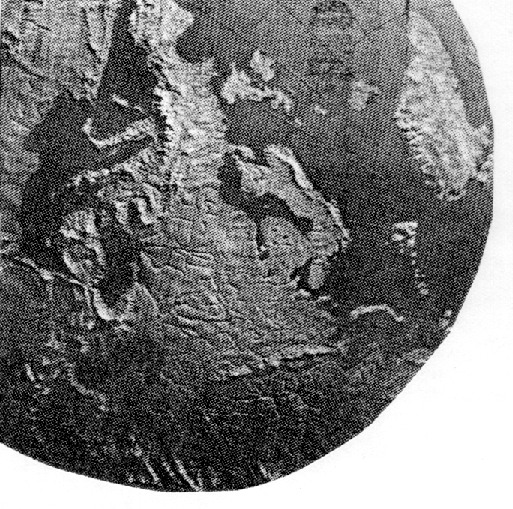Whatever their origins, by the turn of the 13th century, the Cathars were
seen as a major challenge to the authority of the Roman Church. In 1208, Pope
Innocent III launched a Crusade against the heretics in Languedoc. Simon de
Montfort captured Beziers and Carcassone, was proclaimed Count of Carcassone
and the Razes, and then turned his attention to subduing his new County. Rhedae
was destroyed and the area fell under Simon's direct control until his death
at the siege of Toulouse in 1218. The title was then assumed by one of his Lieutenants,
Pierre de Voison.
Recovery from the Cathar Crusade was slow, marred by attacks from brigands
and devastated by the Black Death. The city of Rhedae disappeared forever. In
the 15th century, the current village of Rennes-le-Chateau grew up around the
Chateau of the Voisons and the church of the Magdalene. The Voisons died out
and the holding passed to a daughter and her husband, Pierre Raymond d'Hautpoul.
They restored the Blanchefort name, as Pierre was a cousin of the Trencavels.
The last of the second Blancheforts married Marie de Negre Dables in 1732, and
died without male heir in 1762. Marie died in the old chateau at Rennes on January
17th, 1781.
And there the story might have ended, except for THE CURIOUS PIETY OF MARIE
de BLANCHEFORT. As she had no sons, Marie chose to confess the family secret
to her parish priest, Abbe Bigou of Saint Magdalene's. From his choices would
grow the rest of the story.
Twelve
The Abbe Antoine Bigou is himself one of the mysteries of Rennes-le-Chateau.
Appointed to the village in 1774, his history and background have been obscured
by his times, the French Revolution, and his supposed importance in the later
development of the mystery. And yet, as we look closer at the facts, we find
that almost nothing can be confirmed. Abbe Bigou may there the story might have ended, except for THE CURIOUS PIETY OF MARIE
de BLANCHEFORT. As she had no sons, Marie chose to confess the family secret
to her parish priest, Abbe Bigou of Saint Magdalene's. From his choices would
grow the rest of the story.
Twelve
The Abbe Antoine Bigou is himself one of the mysteries of Rennes-le-Chateau.
Appointed to the village in 1774, his history and background have been obscured
by his times, the French Revolution, and his supposed importance in the later
development of the mystery. And yet, as we look closer at the facts, we find
that almost nothing can be confirmed. Abbe Bigou may have learned a secret from
Marie de Blanchefort, but there is no evidence he created the clues, including
Marie's tombstone, later attributed to him.
But we do have some convincing evidence that Marie de Negre de Blanchefort
had something interesting to pass on. Her husband's great grandfather, Pierre
d'Hautpol who inherited the Chateau and reclaimed the Blanchefort name, left
a will which contained several ancient documents related to his family's origins.
In the last year of Marie's life, she was focused on regaining these papers,
which she did a few months before her death. Could this be the genealogies found
by Sauniere?
Other than this single tangible, and tantalizing, piece of evidence the
rest of the story is based on rumors, speculation and hearsay. In exile during
the French Revolution, the Abbe Bigou apparently told another priest, the Abbe
Cauneille, about his "great secret." He in turn told two other priests
in the area, the Abbe Jean Vie, of Rennes-le-Bains and the Abbe Emile Francois
Cayron, of St. Laurent de la Cabreriesse. One of them, the Abbe Vie, told his
successor, the Abbe Henri Boudet. Abbe Boudet seems to been have a major influence
behind Sauniere.
However, the modern version of the story is the work of Gerard de Sede,
a French researher than this single tangible, and tantalizing, piece of evidence the
rest of the story is based on rumors, speculation and hearsay. In exile during
the French Revolution, the Abbe Bigou apparently told another priest, the Abbe
Cauneille, about his "great secret." He in turn told two other priests
in the area, the Abbe Jean Vie, of Rennes-le-Bains and the Abbe Emile Francois
Cayron, of St. Laurent de la Cabreriesse. One of them, the Abbe Vie, told his
successor, the Abbe Henri Boudet. Abbe Boudet seems to been have a major influence
behind Sauniere.
However, the modern version of the story is the work of Gerard de Sede,
a French researcher who talked to several surviving contemporaries of Boudet
and Sauniere in the early 1960's. One, the Abbe Maurice-Rene Mazieres, is the
end source for the information outlined above. Assuming that this chain of transmission
is basically correct, then the existence of the secret was known by a small
core of local priests through the 19th century. Sauniere knew what he was looking
for, given certain parameters. The only question is: Was he surprised by what
he found?
Thirteen
What did the Grand Dame of the village relate to her personal chaplain before
she died? What did she tell him about the secrets contained in those hard-won
genealogies? Why did he wait ten years, until the eve of the Revolution, to
encode the secret on her tombstone and hide the papers in the altar pillars?
And what did he really tell the Abbe Caunielle before he died in Spain?
We have of course no answers to any of these questions. All anyone can do
is speculate from the available evidence. Examining the history of the region,
we find enough mysterious treasures to make even Sinbad jaded with their extravagance.
Merely to list them is to make one's head swim.
There's the treasure of the Volcae, the Celtic High-Kings, and the treasure
of lost Glanum. Then there's the Visi those hard-won
genealogies? Why did he wait ten years, until the eve of the Revolution, to
encode the secret on her tombstone and hide the papers in the altar pillars?
And what did he really tell the Abbe Caunielle before he died in Spain?
We have of course no answers to any of these questions. All anyone can do
is speculate from the available evidence. Examining the history of the region,
we find enough mysterious treasures to make even Sinbad jaded with their extravagance.
Merely to list them is to make one's head swim.
There's the treasure of the Volcae, the Celtic High-Kings, and the treasure
of lost Glanum. Then there's the Visigothic horde INCLUDING THE TREASURES OF
THE TEMPLE AT JERUSALEM. There's also the Merovingian treasure hidden by Dagobert
II, the loot of Guillem de Gellone AND THE CROWN OF THE JEWISH KING Arthur,
King Ursus, Sigisbert VI Count of Rhedae. And, last but not least, the lost
treasure of the Cathars and the Templars.
When we also add to the mix the strange permutations on a mysterious bloodline,
whether Arthurian, Jewish/Christian or both, THE IDEA OF A SECRET TREASURE BECOMES
EVEN MORE COMPLEX. Rightful owners and usurpers combine in a tangle of conflicting
claims. However, as Nostradamus reminds us, THIS TREASURE SEEMS TO HAVE SOME
SORT OF CURSE ATTACHED TO IT.
Originally taken from the sacred well in Toulouse by Consul Caepio, who
came to a bad end on the road to Marseilles, the treasure was possibly re-hidden
in THE ANCIENT MEGALITHIS PENTAGONAL TEMPLE of which Rennes-le-Chateau is a
part. The treasures of Glanum and the Visigoths added to the horde, which became
the key to THE MEROVINGIAN POWER STRUGGLES. Later it was used to leverage a
Kingdom against the Carolingian power. Given the success of Theodoric and Guillem
de Gellone, and the failure of Sigisbert VI, King Ursus, WE CAN SEE THE CURSE
AT WORK. Perhaps King Ursus financed his attempt at the throne of France with
part of theSE ATTACHED TO IT.
Originally taken from the sacred well in Toulouse by Consul Caepio, who
came to a bad end on the road to Marseilles, the treasure was possibly re-hidden
in THE ANCIENT MEGALITHIS PENTAGONAL TEMPLE of which Rennes-le-Chateau is a
part. The treasures of Glanum and the Visigoths added to the horde, which became
the key to THE MEROVINGIAN POWER STRUGGLES. Later it was used to leverage a
Kingdom against the Carolingian power. Given the success of Theodoric and Guillem
de Gellone, and the failure of Sigisbert VI, King Ursus, WE CAN SEE THE CURSE
AT WORK. Perhaps King Ursus financed his attempt at the throne of France with
part of the sacred treasure. His defeat and exile would suggest some such over-reaching,
even if only political.
It is also possible that the legends of the vast Merovingian treasure played
a part in the Cathar Crusades of the early 13th century. The main effort of
the first wave of Crusaders was to install Simon de Montfort as Count of Carcassone,
Beziers and Razes. In other words, the entire region around Rennes-le-Chateau.
De Montfort destroyed the ancient fortress at Rhedae and most of the surrounding
region. His actions were more of a conqueror in such of loot than any serious
attempt at rulership.
Indeed, de Montfort's stated design was to virtually annihilate the aristocracy
of the Languedoc and replace them with nobility from the north. Control of the
land was the goal, that and the extinction of the ancient ruling families of
the district. Eventually this would turn the Crusade against heretics into a
war to perpetuate de Monfort's conquests., if that had not been the original
object. What was it in Languedoc that Simon was so desperate to control?
Whatever it was, its possession made de Montfort a most unusual and powerful
man. In January 1215, The Council of Montpellier deposed the Count of Toulouse,
Raymond VI, and conferred on Simon de Montfort the unique title of Dominus es to virtually annihilate the aristocracy
of the Languedoc and replace them with nobility from the north. Control of the
land was the goal, that and the extinction of the ancient ruling families of
the district. Eventually this would turn the Crusade against heretics into a
war to perpetuate de Monfort's conquests., if that had not been the original
object. What was it in Languedoc that Simon was so desperate to control?
Whatever it was, its possession made de Montfort a most unusual and powerful
man. In January 1215, The Council of Montpellier deposed the Count of Toulouse,
Raymond VI, and conferred on Simon de Montfort the unique title of Dominus et
Monarcha, or Lord And Ruler, implying some sense of feudal obligation to the
Pope himself. This was reinforced later that year at the Fourth Lateran Council
held in Rome. In spite of a spirited defense by Raymond-Roger, Count of Foix,
the Council confirmed de Montfort's right to rule. The King of France, on April
10, 1216 in a decree issued from Melun, invested de Montfort as the Count of
Toulouse, Carcassone, Beziers and the Razes.
However, at the very moment of his triumph, de Monfort's downfall was already
in the wings. The genesis of that downfall points to the secret of the treasure
and its curse. Like the Consul Caepio, the later day Roman de Montfort seems
to have fallen afoul of the Volcae gold.
In 1211, de Montfort captured the castle of Montferrand, just a few miles
across the valley from Rennes-le-Chateau. The castle was defended by Baldwin,
the younger brother of Count Raymond of Toulouse. As was common at that point
in the struggle, Baldwin switched sides after his capture. However Baldwin's
conversion was sincere, and he became one of de Monfort's chief supporters.
Meanwhile, The Count of Toulouse had gained a powerful ally, Peter II of
Aragon. In September, 1213, de Monfort went out to meet the forces of Aragon
and Toulouse at Muret, just east of Toulouse.Roman de Montfort seems
to have fallen afoul of the Volcae gold.
In 1211, de Montfort captured the castle of Montferrand, just a few miles
across the valley from Rennes-le-Chateau. The castle was defended by Baldwin,
the younger brother of Count Raymond of Toulouse. As was common at that point
in the struggle, Baldwin switched sides after his capture. However Baldwin's
conversion was sincere, and he became one of de Monfort's chief supporters.
Meanwhile, The Count of Toulouse had gained a powerful ally, Peter II of
Aragon. In September, 1213, de Monfort went out to meet the forces of Aragon
and Toulouse at Muret, just east of Toulouse. De Montfort used a small tactical
squad of knights whose goal was the death of the King of Aragon. Either through
devilish unchivalry or divine intervention, de Montfort's knights KILLED Peter
II and the battle collapsed into a massacre. De Montfort won a great victory,
that for a time made him the undisputed ruler of the region. HE HAD WON, OR
SO IT SEEMED.
Baldwin of Toulouse had little to do with the great deeds of the battle
of Muret. He does not seem to have been there. However, he may have already
performed his greatest service to the de Monfort cause. The winter of 1212-13
saw the nadir of de Montfort's fortunes. He was reduced to a few hundred knights
and the Pope was writing letters with vague rumbling threats. By Easter, 1213,
all of this had changed.
Suddenly there was money to hire mercenaries, the core of those tactical
squads that would kill King Peter II, and the morale of the Crusaders became
such that by early summer there was an influx of pilgrims and northern knights
that enlarged de Montfort's forces. His miraculous victory that September silenced
his critics and preparations began for the Church Councils that would eventually
confirm his authority. The Pope, willing or not, no longer had any choice but
to support de Montfort.
Perhaps de Montfort ew hundred knights
and the Pope was writing letters with vague rumbling threats. By Easter, 1213,
all of this had changed.
Suddenly there was money to hire mercenaries, the core of those tactical
squads that would kill King Peter II, and the morale of the Crusaders became
such that by early summer there was an influx of pilgrims and northern knights
that enlarged de Montfort's forces. His miraculous victory that September silenced
his critics and preparations began for the Church Councils that would eventually
confirm his authority. The Pope, willing or not, no longer had any choice but
to support de Montfort.
Perhaps de Montfort persuaded Baldwin, who as the local commander and a
member of the ruling family would have known of the treasure and its secrets,
to reveal it to him in return for some future favors. Baldwin did receive several
principalities from de Montfort, and in 1214, on his way home from receiving
one of these fiefdoms, Baldwin was captured and turned over to his brother and
the Count of Foix.
Baldwin was treated very harshly, far beyond the usual reception of those
who merely changed sides in the conflict. Baldwin was hanged, ceremonially,
as a traitor to something larger than just the family. We can only suppose that
the larger something was the secret itself. Baldwin had betrayed the very heart
of Languedoc and given its treasure to the latest Roman. For that he died an
unpleasant death, the first of many to come.
Three years after the miraculous upturn, Simon was invested as ruler of
the conquered region by the Pope and the French King. If he could have held
his kingdom together, its power along with the secret, would have made de Montfort
a formidable player in medieval power politics. He could have formed a new western
Holy Roman Empire BEHOLDEN DIRECTLY TO THE POPE, one that could in fact have
replaced the crumbling power of the Hohenstauffens, the current Holy Roman Emperors.
But, witret itself. Baldwin had betrayed the very heart
of Languedoc and given its treasure to the latest Roman. For that he died an
unpleasant death, the first of many to come.
Three years after the miraculous upturn, Simon was invested as ruler of
the conquered region by the Pope and the French King. If he could have held
his kingdom together, its power along with the secret, would have made de Montfort
a formidable player in medieval power politics. He could have formed a new western
Holy Roman Empire BEHOLDEN DIRECTLY TO THE POPE, one that could in fact have
replaced the crumbling power of the Hohenstauffens, the current Holy Roman Emperors.
But, within months of receiving the royal authority, it had all turned to ashes.
On his return from his investiture, de Montfort had to force his way into
his capital of Toulouse. He fell into a dispute with one of the mainstays of
the Crusade, the Bishop of Narbonne, and was caught by surprise when the young
Count Raymond VII moved out of Provence with an army as the old Count re-occupied
Toulouse. De Montfort charged off to besiege Toulouse where he died, beheaded
by an artillery stone, on June 25th 1218. De Montfort seems to have had some
prevision of his death, HE WAS PRAYING immediately before he went out to the
attack, and perhaps the secret was heavy on his soul. His death and defeat,
while it did not end the war, did suggest that de Montfort had somehow transgressed
against divine authority.
It is possible that this sense of transgression may have colored how Pierre
de Voison, de Montfort's lieutenant, perceived his inheritance, which in all
probability, contained the secret. The aura of the curse may have lingered all
the way down to the secrets Marie de Blanchefort told the Abbe Bigou. Perhaps
that's why she felt compelled to pass the story along when she died. She may
have felt that it was important to preserve the secret in order to contain the
curse.
Favy on his soul. His death and defeat,
while it did not end the war, did suggest that de Montfort had somehow transgressed
against divine authority.
It is possible that this sense of transgression may have colored how Pierre
de Voison, de Montfort's lieutenant, perceived his inheritance, which in all
probability, contained the secret. The aura of the curse may have lingered all
the way down to the secrets Marie de Blanchefort told the Abbe Bigou. Perhaps
that's why she felt compelled to pass the story along when she died. She may
have felt that it was important to preserve the secret in order to contain the
curse.
Fourteen
To understand what seems to have happened next, we must attempt to enter
the mind of the Abbe Bigou. From the little we know of him, we can speculate
that he was reasonably well educated and, since he had been chaplain for seven
years, he would have been familiar with the history of the region. Therefore,
it must have been quite a shock when the Grand Dame of the village, and possibly
the Abbe's friend, revealed on her death bed the existence of a secret and a
treasure with the curse of Simon de Montfort on it. The Abbe, from that alone,
would have been shocked to his core.
But there was more, those genealogies that Marie de Blanchefort had struggled
to retrieve before she died. If she gave them to the Abbe, did she explain what
they meant? And how did the cursed treasure related to them? Was it a matter
OF WHO HAD THE RIGHT TO THE TREASURE? In that case, with the death of Marie
de Blanchefort who did have the right? THE ABBE BIGOU WAS LEFT WITH AN OVERWHELMING
PROBLEM.
A decade went by before the Abbe solved his problem. However, in that decade,
the very fabric of French society underwent a traumatic change. We have no way
of knowing how involved the Abbe Bigou was in those changes. The research is
lacking, but given what he appears to have done in 1791, shortly be Blanchefort had struggled
to retrieve before she died. If she gave them to the Abbe, did she explain what
they meant? And how did the cursed treasure related to them? Was it a matter
OF WHO HAD THE RIGHT TO THE TREASURE? In that case, with the death of Marie
de Blanchefort who did have the right? THE ABBE BIGOU WAS LEFT WITH AN OVERWHELMING
PROBLEM.
A decade went by before the Abbe solved his problem. However, in that decade,
the very fabric of French society underwent a traumatic change. We have no way
of knowing how involved the Abbe Bigou was in those changes. The research is
lacking, but given what he appears to have done in 1791, shortly before he emigrated
to Spain, the Abbe must have been in contact with one or more occult groups
or secret societies of the time. To see this, we must look briefly at the two
pieces of evidence for which the Abbe was most probably responsible.
The story goes that around 1791, the Abbe Bigou had two strange tombstones
placed over the grave of Marie de Blanchefort in the Rennes-le-Chateau cemetery.
They were later defaced by Sauniere, although copies of them survived in local
antiquarian literature. The most authentic of the pair is the headstone, a pointed
slab with its conventional mortuary inscription curiously riddled with oddities.
At first glance, it reads: "Here lies the Noble Marie de Negre D'Arles
Dame D'Haupol de Blanchefort, aged sixty seven years, died the 17th of January,
1781. May she rest in peace." Almost every line on the stone has some kind
of oddity. One of them is the "D'Arles" of the name. It should be
"D'Ables," but we might perhaps see the reference to Arles as significant
in itself. We find when we pull out the odd letters, that they spell out "Mort
Epee," or Death Sword in French. The odd zero in the Roman numeral of the
date suggests that it should be read as 1681, a thousand years after Sigisbert
IV became Count of R/p>
At first glance, it reads: "Here lies the Noble Marie de Negre D'Arles
Dame D'Haupol de Blanchefort, aged sixty seven years, died the 17th of January,
1781. May she rest in peace." Almost every line on the stone has some kind
of oddity. One of them is the "D'Arles" of the name. It should be
"D'Ables," but we might perhaps see the reference to Arles as significant
in itself. We find when we pull out the odd letters, that they spell out "Mort
Epee," or Death Sword in French. The odd zero in the Roman numeral of the
date suggests that it should be read as 1681, a thousand years after Sigisbert
IV became Count of Rhedae. There is also the missing T in Hautpol and the curious
division of the last phrase. The T is perhaps the cross, or tau, at the center
of the mystery, and the division of "Requiescat in Pace" into "Requies
Catin Pace" emphasizes the French word "catin" or whore which
points again to the Magdalene. If the Abbe Bigou left us anything, it is likely
to be this tombstone. But what is it telling us?
We have clues:
1) The MORT epee, or sword of death suggests the whole tradition of mythical
swords, from Arthur to Roland. It could also be the key word in another cryptogram
or cypher.
2) We have a date of 1681, a hundred years before Marie de Blanchefort's
death. This date puts us in the reign of Louis XIV, the Sun King, and specifically
the time period of the Affair of the Poisons.
3) The missing T points to a hidden cross or tau.
4) The D'Arles/Dables switch points us back to Provence and Arles, with
its Grail connections in particular.
5) The catin or whore reference points to a connection with Mary Magdalene.
The story of the gravestone is even more curious. Supposedly it was done
at the same time as the headstone, but its strange inscription suggests the
involvement of some sort of secret socie have a date of 1681, a hundred years before Marie de Blanchefort's
death. This date puts us in the reign of Louis XIV, the Sun King, and specifically
the time period of the Affair of the Poisons.
3) The missing T points to a hidden cross or tau.
4) The D'Arles/Dables switch points us back to Provence and Arles, with
its Grail connections in particular.
5) The catin or whore reference points to a connection with Mary Magdalene.
The story of the gravestone is even more curious. Supposedly it was done
at the same time as the headstone, but its strange inscription suggests the
involvement of some sort of secret society. Whether this was the result of the
Abbe's lost decade and any occult contacts he may have made is unknown. It is
unlikely that, if the Abbe Bigou actually created the flagstone, he used these
symbols on his own authority. Even more curious, this was also defaced by Sauniere,
and no solid authority exists as to its contents. Several version have been
put forward, including one from a book that apparently doesn't exist, so we
must take care in putting too much weight on any single interpretation.
Apparently the grave stone was inscribed with two lines of Greek letters
on either side of a central Latin inscription. The Latin inscription is divided
by a double-headed arrow which connects a PS in a curious loop at the top with
"Prae-Cum" and a spider at the bottom. The Greek letters are meaningless,
until we transpose them into their Latin equivalents. Then they spell out "Et
In Arcadia Ego," a code phrase that goes all the way back to King Rene.
The central Latin inscription is very ambiguous, both in its lack of grammar
and its split placement, allowing us to read it horizontally, vertically and,
as we will see, radically.
The words are, from upper left going clockwise, Reddis, Regis, Arcis, Cellis.
Assuming that Reddis is Rhedae, then the simplest reading n is divided
by a double-headed arrow which connects a PS in a curious loop at the top with
"Prae-Cum" and a spider at the bottom. The Greek letters are meaningless,
until we transpose them into their Latin equivalents. Then they spell out "Et
In Arcadia Ego," a code phrase that goes all the way back to King Rene.
The central Latin inscription is very ambiguous, both in its lack of grammar
and its split placement, allowing us to read it horizontally, vertically and,
as we will see, radically.
The words are, from upper left going clockwise, Reddis, Regis, Arcis, Cellis.
Assuming that Reddis is Rhedae, then the simplest reading is Rhedae: Royal Fortress
Store-house. This is also, vertically, Rhedae Store-house, Royal Fortress. But
something still seems missing. However the PS and the Prae-cum spider may help
add to our understanding. If we think of prae-cum as the Latin before-with,
and connect that with the PS at the top, another message, which completes the
central inscription, appears.
The PS is enclosed in a loop that goes from before the P to before the S.
If we think of this as the "before" of the prae below, then we should
look for the letters before P and S. They are O and R, Or, the French word for
gold. If we then connect the spider cum or with the PS/OR, we come up with a
clever Green Language pun. Spider in French is araignee, which is pronounced
just like "A Rennes," or "at Rennes." The message then becomes:
"Gold at Rennes, Royal Rhedae the Fortress Store-house: Et in Arcadia ego.
. ."
The grave stone has other clues. There are eight Greek letters on each side
of the central inscription, and 22 letters in the central inscription itself.
The PS/Prae-Cum is written in eight letters, FOR A GRAND TOTAL OF 46.
FORTY SIX is an auspicious number. In esoteric Freemasonry, a 33 degree
Master has the opportunity to advance further by taking 13 extra grhe PS/OR, we come up with a
clever Green Language pun. Spider in French is araignee, which is pronounced
just like "A Rennes," or "at Rennes." The message then becomes:
"Gold at Rennes, Royal Rhedae the Fortress Store-house: Et in Arcadia ego.
. ."
The grave stone has other clues. There are eight Greek letters on each side
of the central inscription, and 22 letters in the central inscription itself.
The PS/Prae-Cum is written in eight letters, FOR A GRAND TOTAL OF 46.
FORTY SIX is an auspicious number. In esoteric Freemasonry, a 33 degree
Master has the opportunity to advance further by taking 13 extra grades or degrees.
Therefore A 46th DEGREE INITIATE IS SUPPOSEDLY A MASTER OF SPACE AND TIME, a
boddhisattva-like enlightened adept. A hint of this can also be gleaned from
the fact that 3 times 46 is 138, the number of the phrase BEN ELOHIM, or "SONS
OF GOD." Other interesting ramifications of the number 46 include the number
of the name of Adam, the first man. It is also said that it took 46 years to
build King Solomon's Temple. Each human being has 46 chromosomes. Forty six
equals the name of God, Elhi, an ancient name for the El in the Sky, the High
God of Draco. It is also the number of the Levite priests who ministered to
that God.
We might think then that the gravestone is the work of a 46th degree initiate
in some kind of secret society. Another clue in the central inscription suggests
which variety. If we take the letters of the central inscription and align them
in a cross with their mutual S at the center, then we find four groups of four
letters each and a fifth group of two letters. These are RC, pointing in a covert
or occult way to the Rosicrucians. Reading the S as a moebius strip connection,
the central S and the four I's around it can be read as ISIS/ISIS. The inscription
can now be read as: ISIS - R(ose) C(ross) - She who rules The Arc - ISIS.
Therefore, t>
We might think then that the gravestone is the work of a 46th degree initiate
in some kind of secret society. Another clue in the central inscription suggests
which variety. If we take the letters of the central inscription and align them
in a cross with their mutual S at the center, then we find four groups of four
letters each and a fifth group of two letters. These are RC, pointing in a covert
or occult way to the Rosicrucians. Reading the S as a moebius strip connection,
the central S and the four I's around it can be read as ISIS/ISIS. The inscription
can now be read as: ISIS - R(ose) C(ross) - She who rules The Arc - ISIS.
Therefore, the gravestone gives us ample evidence of the hand of a secret
society at work in the mystery. When we put the two messages together, one thing
becomes apparent. The headstone points to a mystery, the gravestone attempts
to claim that mystery.
Whatever Abbe Bigou learned, it would sooner or later become the property
of a secret organization. It is doubtful that Bigou was a member of such a society,
but without question it was the Abbe Bigou who brought it to their attention.
Only a group with deep esoteric ties could have placed a tombstone such as Marie
de Blanchefort's in Rennes' cemetery.
The rest of the secret, the genealogies for instance, disappeared, hidden
in all likelihood by the Abbe Bigou when the French Revolution prevented the
secret society that probably placed the tombstone from receiving them. They
remained hidden until the Abbe Berenger Sauniere decided to renovate the church
of the Magdalene in the late 1880's.
Fifteen
Berenger SAUNIERE was born on April 11, 1852 in the small village of Montazels
across the valley from Rennes-le-Chateau. The oldest of seven children, he was
22 when he entered the Seminary in 1874. Ordained in 1879, he was posted first
to Alet, and then to Clat, before arriving at Rennes-le-Chateau in June of 188for instance, disappeared, hidden
in all likelihood by the Abbe Bigou when the French Revolution prevented the
secret society that probably placed the tombstone from receiving them. They
remained hidden until the Abbe Berenger Sauniere decided to renovate the church
of the Magdalene in the late 1880's.
Fifteen
Berenger SAUNIERE was born on April 11, 1852 in the small village of Montazels
across the valley from Rennes-le-Chateau. The oldest of seven children, he was
22 when he entered the Seminary in 1874. Ordained in 1879, he was posted first
to Alet, and then to Clat, before arriving at Rennes-le-Chateau in June of 1885.
We might suppose it was a case of local boy makes good, and from the very beginning
Sauniere acted as if he had a mission. During the heated parliamentary elections
of 1885, Sauniere preached two inflammatory anti-Republican sermons and was
removed for a while to the seminary in Narbonne as punishment. His sudden plunge
into politics foreshadowed the rest of his career. If Sauniere had any enemies
at that point, they were within the church.
Within a year he was back at his post in Rennes-le Chateau, now covered
with monarchical glory. Sauniere received generous support for his proposed
reconstruction efforts from many local royalists. In the spring of 1887, support
of a most surprising kind arrived, in the form of an emissary supposedly from
the widow of the French Pretender, Henri de Bourbon, or, in his own eyes at
least, Henry V of France.
Henry had died in 1885, and with him went all hope of a Bourbon restoration.
His wife, the Comtesse de Chambord, was trying by any means necessary to reinforce
her children's precarious position. Sauniere, as an ardent monarchist, would
have agreed with the Comtesse's desires, but even he must have surprised by
what the emissary offered. Three thousand francs, a fortune to a poor parish
priest, for the restoration of the church, if only he wouhe spring of 1887, support
of a most surprising kind arrived, in the form of an emissary supposedly from
the widow of the French Pretender, Henri de Bourbon, or, in his own eyes at
least, Henry V of France.
Henry had died in 1885, and with him went all hope of a Bourbon restoration.
His wife, the Comtesse de Chambord, was trying by any means necessary to reinforce
her children's precarious position. Sauniere, as an ardent monarchist, would
have agreed with the Comtesse's desires, but even he must have surprised by
what the emissary offered. Three thousand francs, a fortune to a poor parish
priest, for the restoration of the church, if only he would look for something
hidden by one of his predecessors, the Abbe Bigou. It is unlikely that the emissary
told him exactly what they hoped to find, but it is likely that the idea of
genealogical records, perhaps related to the survival of Louis XVII who supposedly
escaped from the Temple in 1791, were mentioned.
Sauniere took the money, and began his search. His first step may been to
make the acquaintance of another local priest, the Abbe Henri Boudet. We know
that they became friends around this time, and we have no evidence that they
knew each other before the visit by the Comtesse's emissary. However, after
Sauniere began his quest, they became deeply entwined with each other and the
secret itself.
The Abbe Henri Jean-Jacques Boudet was a generation older than Sauniere,
born in 1837 at Quillan. He was ordained in 1861 and by 1872 had become the
parish priest of Rennes-le-Bains, a neighboring village which was the site of
several ancient structures, including a Roman hot springs bath. His predecessor
at Rennes-le-Bains was the Abbe Jean Vie, one of the two priests to whom Abbe
Caunielle entrusted the Abbe Bigou's secret. The core of the secret passed,
either directly or indirectly, to the Abbe Boudet.
For eight years after his appointment, Boudet worked on the secret frbecame deeply entwined with each other and the
secret itself.
The Abbe Henri Jean-Jacques Boudet was a generation older than Sauniere,
born in 1837 at Quillan. He was ordained in 1861 and by 1872 had become the
parish priest of Rennes-le-Bains, a neighboring village which was the site of
several ancient structures, including a Roman hot springs bath. His predecessor
at Rennes-le-Bains was the Abbe Jean Vie, one of the two priests to whom Abbe
Caunielle entrusted the Abbe Bigou's secret. The core of the secret passed,
either directly or indirectly, to the Abbe Boudet.
For eight years after his appointment, Boudet worked on the secret from
the clues that the Abbe Vie had passed on to him. By 1880, he had completed
the manuscript of a vast masterwork entitled THE TRUE CELTIC LANGUAGE and the
Megaliths of Rennes-le-Bains. It took six more years before the work was published,
at the Abbe's expense, and then it was roundly criticized as being "a fantastical
and indescribable work." The Abbe himself tells us early on in the book
that it is written in a kind of Green Language code. "Speaking a certain
jargon from outside," as Boudet calls it, which suggests the alchemist
Fulcanelli's description of the Green Language as the argot or cant of the outsiders,
in his Mystery of the Cathedrals, another book pronounced as unreadable by those
who haven't read it..
But, by the time the Comtesse's emissary arrived, the Abbe's book had circulated
in some very interesting circles. He sent 100 copies to various "interested
persons," such as heads of states, kings, political figures and so on.
One of those copies found its way, no doubt, into the hands of the Comtesse
or some one in her circle. However, the book itself is totally obscure without
a key. The fact that the Comtesse responded at all is oblique proof that the
Abbe Bigou had related at least part of the secret to some kind of royalist
secret society just bf the Cathedrals, another book pronounced as unreadable by those
who haven't read it..
But, by the time the Comtesse's emissary arrived, the Abbe's book had circulated
in some very interesting circles. He sent 100 copies to various "interested
persons," such as heads of states, kings, political figures and so on.
One of those copies found its way, no doubt, into the hands of the Comtesse
or some one in her circle. However, the book itself is totally obscure without
a key. The fact that the Comtesse responded at all is oblique proof that the
Abbe Bigou had related at least part of the secret to some kind of royalist
secret society just before the French Revolution. The question of why didn't
they contact Boudet directly may be answered by reflecting on the fact that
Boudet may have already known too much. Sauniere however, might have been fooled
initially by the Louis XVII smoke screen.
And so he began his restoration work. In front of the main altar, supported
on an ancient stone pillar engraved with the Visigothic Cross of Silence, Sauniere
made his first discovery. The story is that as the altar pillar was moved, it
slipped and cracked both itself and the flagstone on which it fell. The flagstone,
when turned over, revealed an ancient Merovingian design on its face and the
entrance to a vault or crypt. Apparently, there was also some sort of gold cache
as well, for the rumors started almost immediately. In a village the size of
Rennes-le-Chateau, roughly two hundred people at this point, nothing could be
kept truly secret.
Work halted while Sauniere explored the discovery. In addition to the vault
and its curious stone, Sauniere also found a wooden tube filled with parchments
in the hollow base of the Visigothic pillar. After a few months, Sauniere moved
the Merovingian stone to the cemetery and closed the vault back up. He also
seems to have conferred with the Abbe Boudet over the parchments he found. He
does no entrance to a vault or crypt. Apparently, there was also some sort of gold cache
as well, for the rumors started almost immediately. In a village the size of
Rennes-le-Chateau, roughly two hundred people at this point, nothing could be
kept truly secret.
Work halted while Sauniere explored the discovery. In addition to the vault
and its curious stone, Sauniere also found a wooden tube filled with parchments
in the hollow base of the Visigothic pillar. After a few months, Sauniere moved
the Merovingian stone to the cemetery and closed the vault back up. He also
seems to have conferred with the Abbe Boudet over the parchments he found. He
does not seem to have directly notified the Comtesse of his discovery.
We should also note that the famed wealth of Sauniere had yet to arrive.
Other than the generous donations for the restoration work, which all seems
to have been spent on the church, Sauniere was still living the life of a simple
parish priest. The Comtesse's 3,000 francs are accounted for in the new altar
and stained glass of the church, and very little else in the way of restoration
was done for four years. In that time, Sauniere was busy with other matters,
including a long stay at Antugnac near his home village of Montazels.
All was quiet until the summer of 1891, when the pieces of the puzzle apparently
came together in a major discovery. From that point on, Sauniere lived and acted
as a wealthy man. One who was also beyond the censure of the church. In fact,
after 1891, Sauniere acted as if he were the rightful owner of the secret. Perhaps,
during his stay in Antugnac, Sauniere added his own branch to the family tree
found in the Visigothic pillar. However, all we can say for sure is that by
the summer of 1891, things had changed, and they would never be the same agaim.
Sixteen
To understand what happened at Rennes-le-Chateau between 1887 and 1891,
we must step back and look n the pieces of the puzzle apparently
came together in a major discovery. From that point on, Sauniere lived and acted
as a wealthy man. One who was also beyond the censure of the church. In fact,
after 1891, Sauniere acted as if he were the rightful owner of the secret. Perhaps,
during his stay in Antugnac, Sauniere added his own branch to the family tree
found in the Visigothic pillar. However, all we can say for sure is that by
the summer of 1891, things had changed, and they would never be the same agaim.
Sixteen
To understand what happened at Rennes-le-Chateau between 1887 and 1891,
we must step back and look at one of Europe's oldest dynasties, THE HAPSBURGS.
The historical origin of the Hapsburg family goes back to the 10th century and
the intrigues of Otto I, the first Hohenstauffen to become Emperor of Charlemagne's
revived Holy Roman Empire. At that point the empire consisted of little more
than a collection of Germanic states. In 1273, Rudolph of Hapsburg -- a loose
conglomeration of family holdings in Alsace, Swabia and the Black Forest --
was chosen to be the new Emperor. His most important action was to drive the
King of Bohemia out of the Ostmark, or eastern regions, of Charlemagne's Empire,
WHICH INCLUDED THE FORTRESS CITY OF VIENNA. As Emperor, Rudolph made over the
city and region around it, Austria or the eastern land, to members of his family.
In that way the House of Hapsburg became the House of Austria.
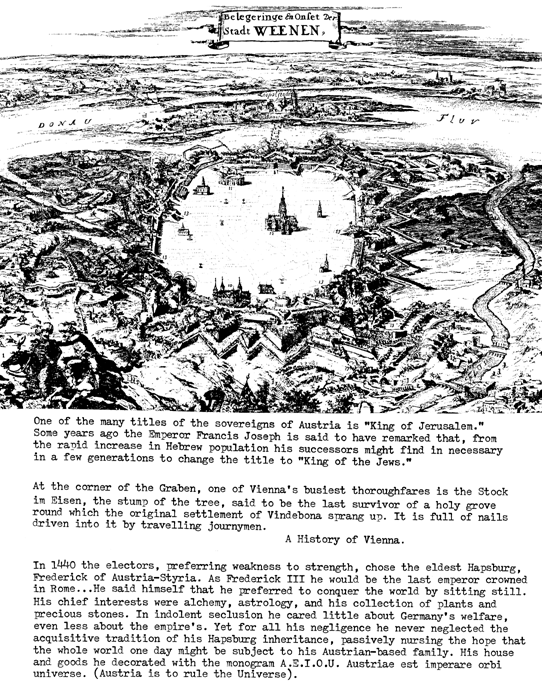

For most of the six hundred years between Rudolph of Hapsburg and Crown
Prince Rudolph, the history of Europe really was the history of the Hapsburg.
Alone of all the dynasties of Europe, the Hapsburgs were not bound to a certain
homeland from which they ruled. Indeed, the Hapsburgs grew to rule much of Europe
throughph made over the
city and region around it, Austria or the eastern land, to members of his family.
In that way the House of Hapsburg became the House of Austria.


For most of the six hundred years between Rudolph of Hapsburg and Crown
Prince Rudolph, the history of Europe really was the history of the Hapsburg.
Alone of all the dynasties of Europe, the Hapsburgs were not bound to a certain
homeland from which they ruled. Indeed, the Hapsburgs grew to rule much of Europe
through family connections, and their right to be rulers rested on their bloodline.
The Hapsburgs were important for who they were, as much or more than for what
they owned. However, the origin of this right to rule is obscure.
Many genealogies were compiled through the centuries by court appointed
researchers who traced the origin of the Hapsburgs BACK TO SUCH ANCIENT LUMINARIES
AS JULIUS CAESAR AND PRIAM OF TROY. A more likely lineage goes back to the Merovingian
heartland of Austrasia. The anarchy in Austrasia after Dagobert II's murder
was probably the moment when the Hapsburgs first emerged on the stage of history.
They survived the Carolingian era by supporting the stronger side, just as they
later supported the Hohenstauffens. IN THE SLOW GROWTH OF HAPSBURG POWER, THERE
IS A SENSE, SOMEHOW, OF AN EVIL MENACE WAITING IN THE WINGS.
Once the Hapsburg gained control of the Holy Roman Empire, they remained
in control until its dissolution BY NAPOLEON in 1806. The Treaty of Vienna in
1818 created the Dual monarchy of Austria-Hungary, which was the Old Empire
in all but name, and without its German and Italian provinces. As revolution
swept through Europe in 1848, the Archduke Franz Joseph became Emperor of Austria-Hungary.
He would rule for 68 years, and in the end would die before his beloved Emp by supporting the stronger side, just as they
later supported the Hohenstauffens. IN THE SLOW GROWTH OF HAPSBURG POWER, THERE
IS A SENSE, SOMEHOW, OF AN EVIL MENACE WAITING IN THE WINGS.
Once the Hapsburg gained control of the Holy Roman Empire, they remained
in control until its dissolution BY NAPOLEON in 1806. The Treaty of Vienna in
1818 created the Dual monarchy of Austria-Hungary, which was the Old Empire
in all but name, and without its German and Italian provinces. As revolution
swept through Europe in 1848, the Archduke Franz Joseph became Emperor of Austria-Hungary.
He would rule for 68 years, and in the end would die before his beloved Empire.
IT WOULD NOT LONG SUCCEED HIM.
But in the mid 1880's, this was in the future and the Hapsburgs of Austria-Hungary
were the most powerful ruling family in Europe. They enter the story of Rennes-le-Chateau
with the arrival of the emissary, supposedly sent on behalf of the Comtesse
de Chambord, the former Marie de Hapsburg-Lorraine, daughter of Leopold II,
Archduke of Tuscany and the Piedmont of Italy, and widow of the Pretender, Henry
V of France. Her titles and family connections are important, because it is
likely that her supposed emissary was her youngest brother, Johann Salvator
de Hapsburg-Lorraine. It is also likely that the Comtesse had nothing to do
with it, beside providing a convenient cover story.
The Abbe Boudet sent his book to all the ruling families of Europe including
the Hapsburgs, and given their history, the Hapsburg-Lorraines in particular.
Descended from King Rene's grandson and his marriage to a Hapsburg princess
in the late 15th century, the Hapsburg-Lorraines have often been called the
Latinized Hapsburgs. Their long reign in northern Italy and Provence seems to
have inspired these Hapsburgs with something lacking in their Austrian cousins.
However, by the middle of the 19th century, the Grand Dukes of Tuscany had
fallen on hard times. Leoe had nothing to do
with it, beside providing a convenient cover story.
The Abbe Boudet sent his book to all the ruling families of Europe including
the Hapsburgs, and given their history, the Hapsburg-Lorraines in particular.
Descended from King Rene's grandson and his marriage to a Hapsburg princess
in the late 15th century, the Hapsburg-Lorraines have often been called the
Latinized Hapsburgs. Their long reign in northern Italy and Provence seems to
have inspired these Hapsburgs with something lacking in their Austrian cousins.
However, by the middle of the 19th century, the Grand Dukes of Tuscany had
fallen on hard times. Leopold II, Marie and Johann's father, backed his cousin
the Emperor Franz Joseph in the struggles for Italian independence. After the
Emperor's defeat at Soliferno in 1859, Leopold lost the Grand Duchy. It became
part of Victor Emmnauel's new Kingdom of Italy. Leopold's eldest son Ferdinand
renounced his claim to the throne, as did the middle brother Ludwig, who became
a locksmith. Johann, the youngest, became the last hope of the family for greatness.
It was a role that, subsequent history would suggest, he wore with some reluctance.
By 1887, Johann had already come into conflict with his cousin, the Emperor
Franz Joseph, and ended any hope of advancement within the House of Hapsburg.
Johann was a renegade archduke, a man with ambitions, a divine sense of authority,
and no way to express his talents and abilities. He was friends with liberals,
free thinkers, and his Christianity was in doubt, A SERIOUS QUESTION IN CATHOLIC
VIENNA. He was known to have joined several chivalric secret orders, such as
the Knights of the Rosy-Cross and the Order of the Crescent founded by his ancestor,
King Rene, in which he was the hereditary Grand Master. Given his background
and interests, it would be surprising if Boudet's book had not reached him.
And so, in the spring of 1887, Archduke Johann paid a visit tancement within the House of Hapsburg.
Johann was a renegade archduke, a man with ambitions, a divine sense of authority,
and no way to express his talents and abilities. He was friends with liberals,
free thinkers, and his Christianity was in doubt, A SERIOUS QUESTION IN CATHOLIC
VIENNA. He was known to have joined several chivalric secret orders, such as
the Knights of the Rosy-Cross and the Order of the Crescent founded by his ancestor,
King Rene, in which he was the hereditary Grand Master. Given his background
and interests, it would be surprising if Boudet's book had not reached him.
And so, in the spring of 1887, Archduke Johann paid a visit to the Abbe
Sauniere under the guise of an emissary from his sister, Marie de Chambord,
with a plausible cover story for looking for the Abbe Bigou's hidden genealogies.
After Sauniere made his initial discovery, he did not try to contact the Comtesse,
but he was in close contact with Archduke Johann. In the fall of 1887, bank
accounts were opened on the same day in the same Austrian bank by both Johann
and the Abbe Sauniere. Transactions between these two accounts would continue
for years, even after Johann's disappearance. They would later form the basis
of an accusation of spying leveled against Sauniere.
From the fall of 1887 to the summer of 1889, Johann seems to have been a
frequent visitor to Rennes-le-Chateau. To the locals, he became the Stranger,
and was remembered long afterward as Monsieur Guillame. During those visits,
the three co-conspirators, Sauniere, Johann and Boudet, unraveled the mystery.
It revealed a discovery so powerful that the Archduke Johann took it to his
cousin, the Crown Prince Rudolph of Austria-Hungary, AND THEREBY SET OFF A TRAIN
OF EVENTS THAT LED, INEXORABLY, TO THE CATACLYSM OF WORLD WAR I.
Seventeen
Let us imagine that it is a gloomy fall afternoon in 1887. The renovations
to the Church of the Magdalene have halted since of 1889, Johann seems to have been a
frequent visitor to Rennes-le-Chateau. To the locals, he became the Stranger,
and was remembered long afterward as Monsieur Guillame. During those visits,
the three co-conspirators, Sauniere, Johann and Boudet, unraveled the mystery.
It revealed a discovery so powerful that the Archduke Johann took it to his
cousin, the Crown Prince Rudolph of Austria-Hungary, AND THEREBY SET OFF A TRAIN
OF EVENTS THAT LED, INEXORABLY, TO THE CATACLYSM OF WORLD WAR I.
Seventeen
Let us imagine that it is a gloomy fall afternoon in 1887. The renovations
to the Church of the Magdalene have halted since the summer, but we may reasonably
suppose it had been cleared enough to be serviceable to its small congregation.
On this afternoon, let us imagine that three men are bending over several unrolled
parchments spread on a board table in the chancel of the church, near where
the altar pillar once stood.
Two of the men are close to the same age. The tall, blond and aristocratically
correct Johann contrasts sharply with the short, barrel chested Languedocian
dynamo of his contemporary, the Abbe Sauniere. It is Sauniere's enthusiasm for
"buried treasure" that has brought them this far. However, it is the
third member of the trio who has undoubtedly made the most profound contribution.
Fourteen years older, the quiet and reserved Abbe Boudet is the authority on
the subject.
Since we are looking through the window of our imagination, let us also
observe the entrance of a shy and sensitive 19 year old village girl, Marie
Denaraud. She asks if anyone needs anything, tea, a cold sandwich, a nip of
something stronger to cut through the chill in the church, perhaps? They smile,
as she is quite lovely in an innocent and unspoiled way, and she is pleased
and flattered that she is taking care of such serious and important people.
Perhaps, as she returns with the brandy, she lingers and coundoubtedly made the most profound contribution.
Fourteen years older, the quiet and reserved Abbe Boudet is the authority on
the subject.
Since we are looking through the window of our imagination, let us also
observe the entrance of a shy and sensitive 19 year old village girl, Marie
Denaraud. She asks if anyone needs anything, tea, a cold sandwich, a nip of
something stronger to cut through the chill in the church, perhaps? They smile,
as she is quite lovely in an innocent and unspoiled way, and she is pleased
and flattered that she is taking care of such serious and important people.
Perhaps, as she returns with the brandy, she lingers and contributes to the
conversation. In our imagination let us suppose that it was Marie's knowledge
of local customs and ancient legends that finally solved the puzzle.
The conversation becomes heated, with Johann drawing geometric designs on
tracings of the ancient parchments. Boudet keeps shaking his head, none match
his piece of the puzzle. Why, Sauniere asks, why this strange five-sided geometry?
What could that have to do with anything?
And then, in our imagination, Marie responds with the story of the five
pointed star on the land, and the group falls silent as they mull it over. Marie
shows them on the map, and suddenly, everyone is talking at once. By morning,
the basic outlines of the mystery have been solved, and the intrepid trio sets
off to uncover the secret with Marie leading the way.
If it did not happen like that, it certainly should have. There is an unmistakably
aura of romance to the story, and if Hollywood ever does a version, we can be
sure it will happen just that way.
Part III - The Secret Emerges
Eighteen
What clues did they have? What did they have to go on as they worked their
way through the puzzle?
They had Marie de Blanchefort's headstone, the crypt discovered under the
is talking at once. By morning,
the basic outlines of the mystery have been solved, and the intrepid trio sets
off to uncover the secret with Marie leading the way.
If it did not happen like that, it certainly should have. There is an unmistakably
aura of romance to the story, and if Hollywood ever does a version, we can be
sure it will happen just that way.
Part III - The Secret Emerges
Eighteen
What clues did they have? What did they have to go on as they worked their
way through the puzzle?
They had Marie de Blanchefort's headstone, the crypt discovered under the
church, and they had the parchments Sauniere found in the Visigothic pillar.
Along with that, they had Boudet's knowledge derived third hand from Bigou,
and they had Johann's knowledge of esoteric subjects. Sauniere supplied the
motive force which kept everything in motion.
The parchments apparently consisted of two geneological tables, one relating
Pierre D'Hautpol to the Kings of Septimania, and the other relating those kings
to Sigisbert IV, and perhaps through his mother's side to the Holy Family. Certainly
his father's side was the main branch of the Merovingians. These geneologies
could be checked through the family records of the Hapsburgs, available by discreet
inquiry to Johann.
Along with the geneologies were two other parchments, each a badly botched
version of a passage from the New Testament. At first glance, it is not apparent
that whoever did the tombstone, also did these parchments. As we look closer
however, the mystery deepens.
Parchment One appears to be an inaccurately copied version of Jesus' parable
OF HARVESTING CORN ON THE SABBATH, a story which appears in all three synoptic
gospels (Luke 6:1-4, Matthew 12: 1-4 and Mark 2: 23-26) and has long been considered
a metaphor for spiritual alchemy. Other than the bad Latin of the version, which
followsurgs, available by discreet
inquiry to Johann.
Along with the geneologies were two other parchments, each a badly botched
version of a passage from the New Testament. At first glance, it is not apparent
that whoever did the tombstone, also did these parchments. As we look closer
however, the mystery deepens.
Parchment One appears to be an inaccurately copied version of Jesus' parable
OF HARVESTING CORN ON THE SABBATH, a story which appears in all three synoptic
gospels (Luke 6:1-4, Matthew 12: 1-4 and Mark 2: 23-26) and has long been considered
a metaphor for spiritual alchemy. Other than the bad Latin of the version, which
follows the Gospels, there are three additional crosses in the text. At the
top is a triangle with an M above it and what looks like the letter I inside
of it. The lines which form the triangle extend beyond the corner on the right
side of the triangle. At the bottom are four extra words and PS.
Parchment One
The four words, "Redis bles solis saceradotibus," can easily be
read in Latin and French as "Rhedae "corn" only for the sacred
initiated." Corn in French is slang for gold, much as bread is slang for
money in America. Before we look any farther, -- it is perhaps the first thing
we read as we glance at the parchment -- we see the clear statement that Rhedae's
gold is only for the sacred initiates. This message however merely begins our
search for meaning. It is likely that's what it was intended to do.
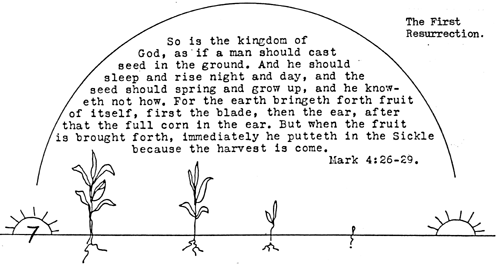
Out of the Middle East, across Europe to America
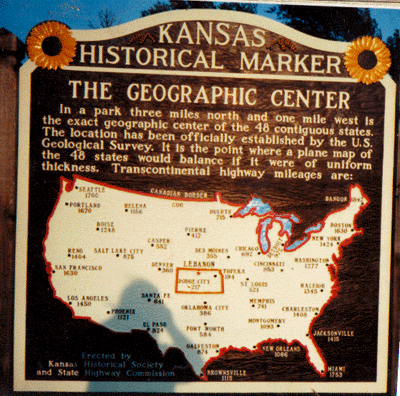
The area now called Rice County has long been a crossroads, even before the
coming of the White man. In ancient times, Native Americans lived here, and
apparently prospered. Many Indian ance at the parchment -- we see the clear statement that Rhedae's
gold is only for the sacred initiates. This message however merely begins our
search for meaning. It is likely that's what it was intended to do.

Out of the Middle East, across Europe to America

The area now called Rice County has long been a crossroads, even before the
coming of the White man. In ancient times, Native Americans lived here, and
apparently prospered. Many Indian artifacts have been collected in the area,
and a few of these are on display in the museum.
Later, Spanish explorers would visit the area, most notably, Coronado. He
was in search of the fabled "City of Gold". His Indian guides would
always insist his destination was only a day or two farther away. It was in
the area of Rice County that Coronado finally tired of this folly, and in
anger and disgust, killed his guides and returned to Mexico. If Coronado were
to return to the area today, in the month of June, he would witness a vast
carpet of gold--the golden ripe Kansas wheat (AND CORN). Of course, this was
not the sort of gold he sought, but over the years the soil he tread upon
here has grown millions of bushels of wheat which has been worth many times
over the gold he longed for that existed only in fable.
..."Redis bles solis saceradotibus" at the bottom right of Parchment
One.
As we read the disclaimer -- For Initiates Only! -- our eyes are drawn to
the right, where the text is truncated in lines 11 - 14 to set off the warning
mto return to the area today, in the month of June, he would witness a vast
carpet of gold--the golden ripe Kansas wheat (AND CORN). Of course, this was
not the sort of gold he sought, but over the years the soil he tread upon
here has grown millions of bushels of wheat which has been worth many times
over the gold he longed for that existed only in fable.
..."Redis bles solis saceradotibus" at the bottom right of Parchment
One.
As we read the disclaimer -- For Initiates Only! -- our eyes are drawn to
the right, where the text is truncated in lines 11 - 14 to set off the warning
message. Immediately, we see SION spelled out vertically on the line ends. The
word "SION" spelled out vertically. The odd placement of the "O"s
will become meaningful.
But, before we begin to suspect the work of the mysterious Priory of Sion,
we must look at how this keyword would have understood by the conspirators.
The enigmatic PS signature.
The word "Zion" first appears in the Bible in 2 Samuel 5:7 where
David conquers the city of the Jebusites, and their fortress/temple of Zion.
The word has no known meaning or origin. A search of possible roots in Canaanite,
Coptic, heriatic Egyptian, and Hebrew turns up nothing helpful. Over time, Zion
and Mt. Zion became synonyms for Jerusalem itself.
Jerusalem was first occupied in the 3rd millennium BCE and was a royal city
in the time of Abraham. Melchizedek introduces Abraham to the God Most High,
and Abraham does his famous sacrifice where the "blazing torch" passed
through the middle, on Mt. Moriah which is identified with Mt. Zion in Davidic
times (2 Chronicles 3:1). Mt. Zion is therefore the place where covenants with
God are made.
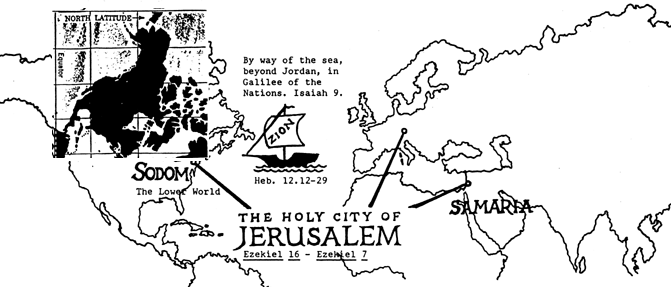
And the Great City was divided into Three pturns up nothing helpful. Over time, Zion
and Mt. Zion became synonyms for Jerusalem itself.
Jerusalem was first occupied in the 3rd millennium BCE and was a royal city
in the time of Abraham. Melchizedek introduces Abraham to the God Most High,
and Abraham does his famous sacrifice where the "blazing torch" passed
through the middle, on Mt. Moriah which is identified with Mt. Zion in Davidic
times (2 Chronicles 3:1). Mt. Zion is therefore the place where covenants with
God are made.

And the Great City was divided into Three parts...Revelation
16.
David treated it as such, building his new capital around it. Mt. Zion was
also the location of the original resting place of the Arc of the Covenant when
David brought it from Mt. Tabor to his new capital. It was on the "threshing
floor of Oruan" on Mt. Zion that David danced before the Arc of God and
received the assurance of divine kingship. In this kingly Davidic covenant,
God tells David that his son will be the one to build a great temple. (continued)...
REAL-LIFE RAIDERS
HUNT ARK OF THE COVENANT
Relic searchers dig near Jesus' crucifixion site in quest for chest holding
10 Commandments
By Joe Kovacs
For centuries, many have wondered
whatever happened to the Ark of the Covenant, the box the Bible says contained
the Ten Commandments of God. Now, a new quest is underway for the legendary
chest featured in the film "Raiders of the Lost Ark," trying to
prove the claim the Ark is buried below the purported site where Jesus Christ
was crucified. An international team has just compNANT
Relic searchers dig near Jesus' crucifixion site in quest for chest holding
10 Commandments
By Joe Kovacs
For centuries, many have wondered
whatever happened to the Ark of the Covenant, the box the Bible says contained
the Ten Commandments of God. Now, a new quest is underway for the legendary
chest featured in the film "Raiders of the Lost Ark," trying to
prove the claim the Ark is buried below the purported site where Jesus Christ
was crucified. An international team has just completed what it calls its
first stage of exploration, spending two weeks beneath Mount Moriah outside
the walls of ancient Jerusalem.
Some 30 explorers from the U.S.,
Australia, Norway and Estonia have been in a cave system north of the city's
Damascus Gate to try to determine if the Ark is indeed located there. The
group is trying to verify the claim made by relic hunter Ron Wyatt who said
he actually saw the Ark there two decades ago after tunneling through a small
passageway.
Wyatt died of cancer in 1999 after
years of searching for biblical antiquities, claiming to have found Noah's
Ark near Mount Ararat in Turkey, the remains of Pharaoh's chariots that chased
Moses through the Red Sea, and the "true" location of Mount Sinai
in Arabia. "I just want to know the truth, whatever it is," says
Richard Rives, president of Wyatt Archaeological Research in Cornersville,
Tenn., which is spearheading the latest effort.
While members of his group are
not archaeologists by trade – they're doctors, nurses, structural and
construction engineers, and businessmen – they are teaming with professirching for biblical antiquities, claiming to have found Noah's
Ark near Mount Ararat in Turkey, the remains of Pharaoh's chariots that chased
Moses through the Red Sea, and the "true" location of Mount Sinai
in Arabia. "I just want to know the truth, whatever it is," says
Richard Rives, president of Wyatt Archaeological Research in Cornersville,
Tenn., which is spearheading the latest effort.
While members of his group are
not archaeologists by trade – they're doctors, nurses, structural and
construction engineers, and businessmen – they are teaming with professional
archaeologists from the Israel Antiquities Authority, which has sanctioned
the dig. In 1982, Wyatt entered the caves from a location since sealed, but
believed there was an alternate passageway used by the prophet Jeremiah to
protect the Ark from invading Babylonians some 600 years before the birth
of Christ. Ironically, during his Ark quest 21 years ago, Wyatt and his crew
decided to take a break and go to the movies. Unaware of what was playing,
they were surprised to see "Raiders of the Lost Ark," which had
just been released.
This summer's research team used
ground-penetrating radar to peer below the surface, trying to pinpoint the
alleged tunnel of Jeremiah. Rives believes they met great success while taking
samples behind a man-made wall. David and Richard Rives at man-made wall that
could conceal passageway to Ark (wyattmuseum.com).
"We found a void where Ron
said there would be a passageway," Rives said. It's at the end of that
passageway where Wyatt believed the sacred container rests. But once the diggers
started excavating beneath the wall, they encountered a problem forcing a
halt to the hunt. "We lost our ceiling to preve ground-penetrating radar to peer below the surface, trying to pinpoint the
alleged tunnel of Jeremiah. Rives believes they met great success while taking
samples behind a man-made wall. David and Richard Rives at man-made wall that
could conceal passageway to Ark (wyattmuseum.com).
"We found a void where Ron
said there would be a passageway," Rives said. It's at the end of that
passageway where Wyatt believed the sacred container rests. But once the diggers
started excavating beneath the wall, they encountered a problem forcing a
halt to the hunt. "We lost our ceiling to prevent collapse," Rives
said. "The people in the antiquities department insisted we stop and
do more architectural engineering to determine what it would take to continue
safely." The group is now studying the situation WITH EXPERTS and hopes
to be back in business within the next six months.
This latest search effort reignites
debate over whether or not the Ark is even located there, since many theories
have sprouted concerning the container's whereabouts. Some claim it's currently
in Ethiopia, having been brought there after a visit to Solomon's Temple by
the ancient Queen of Sheba. Others have suggested the box is hidden in Spain,
Canada, Elephantine Island in Egypt, the Baltic Sea island of Bornholm and
even somewhere in America near Utah. The Bible's final mention of the Ark
recounts King Josiah's order to return the chest to the temple: Put the Holy
Ark in the house which Solomon the son of David king of Israel did build;
it shall not be a burden upon your shoulders. (2 Chronicles 35:3) Spiros Zodhiates,
editor of the Hebrew-Greek Key Word Study Bible, expounds on the Ark's possible
fae subsequent to that verse.
"It may have been carried
awayeen of Sheba. Others have suggested the box is hidden in Spain,
Canada, Elephantine Island in Egypt, the Baltic Sea island of Bornholm and
even somewhere in America near Utah. The Bible's final mention of the Ark
recounts King Josiah's order to return the chest to the temple: Put the Holy
Ark in the house which Solomon the son of David king of Israel did build;
it shall not be a burden upon your shoulders. (2 Chronicles 35:3) Spiros Zodhiates,
editor of the Hebrew-Greek Key Word Study Bible, expounds on the Ark's possible
fae subsequent to that verse.
"It may have been carried
away by [Babylonian King] Nebuchadnezzar along with the other saved articles,
when he plundered the temple," Zodhiates writes. "Since no reference
is made to the Ark by Ezra, Nehemiah or even [Roman historian] Josephus after
the capitivity, it is believed that there was no Ark in the second temple
and that the Holy of Holies [where the Ark was situated in the temple] stood
empty."
Biblical scholar and modern-day
relic hunter Mike Sanders, who has gained notoriety with his Biblical Mysteries
programs, believes the original Ark was destroyed by a different pagan king,
and a replica was constructed to replace it. "The Ark was certainly taken
by the Egyptian King Shishak," Sanders told WorldNetDaily. "There
were obviously subsequent copies made as there were of all the other temple
accoutrements which were also looted many times over the centuries. This has
enabled the myth makers to come up with many wild and wonderful scenarios."
Sanders believes the Ark's contents
– the stone tablets etched by God with the Ten Commandments – are
located in the foundation deposit of an Egyptian temple he discovered in the
Judean hills. " replica was constructed to replace it. "The Ark was certainly taken
by the Egyptian King Shishak," Sanders told WorldNetDaily. "There
were obviously subsequent copies made as there were of all the other temple
accoutrements which were also looted many times over the centuries. This has
enabled the myth makers to come up with many wild and wonderful scenarios."
Sanders believes the Ark's contents
– the stone tablets etched by God with the Ten Commandments – are
located in the foundation deposit of an Egyptian temple he discovered in the
Judean hills. "Hopefully we will extract the contents live on the Internet
and on television sometime early next year when the situation in Israel is
somewhat safer," he says. Sanders is among those critical of Wyatt's
assertions about the Ark.
"When he was alive, I spent
some time asking him questions and asking for evidence [regarding] his claims.
None was ever forthcoming to me or anyone else," Sanders said. "In
those areas where I have done some investigations, he has proven to be a charlatan."
Just days before his death, Wyatt granted an interview to WorldNetDaily, and
addressed such criticism from his detractors. "There's nothing [that]
can be done to prevent ridicule that I'm aware of," Wyatt said. "I
don't think it would be appropriate to deny people the opportunity of using
ridicule because I think that's part of showing their true character."
During the interview, Wyatt explained he found an earthquake crack directly
below the place where the wood on which Jesus was crucified would have been.
The cleft extends down through the rock to the resting place of the Mercy
Seat representing God's throne atop the Ark of the Covenant. The blood of
Christ would have flowed through that crevice addressed such criticism from his detractors. "There's nothing [that]
can be done to prevent ridicule that I'm aware of," Wyatt said. "I
don't think it would be appropriate to deny people the opportunity of using
ridicule because I think that's part of showing their true character."
During the interview, Wyatt explained he found an earthquake crack directly
below the place where the wood on which Jesus was crucified would have been.
The cleft extends down through the rock to the resting place of the Mercy
Seat representing God's throne atop the Ark of the Covenant. The blood of
Christ would have flowed through that crevice after his death and after his
side had been pierced by a soldier's spear.
The Bible teaches the concept of
sacrifice of animals, symbolic of the actual blood sacrifice Christ would
make. The act of Christ, regarded by some as the great High Priest, permitting
himself to be sacrificed and placing his own blood upon the Mercy Seat was
the great and final act in the process of blood sacrifice, according to Wyatt's
writings. And while Wyatt believed the Ark itself would never be moved from
its current location, he thought the laws of God inside it would eventually
be removed and put on display as a testimony to the world.
"This last revelation is for
the inhabitants of the Earth who don't have a clue, as well as for those of
us who do have a clue and have been commissioned by Christ to reach out to
help bring these people who don't have a clue into the fold," Wyatt told
WorldNetDaily. "So these are tools that God has given the believers to
strengthen their faith and to reach out with. They are tools that will be
extremely effective in these the last pouring out to the entire population,
all inhabitants of the Earth." Rives says from a biblical standpointdisplay as a testimony to the world.
"This last revelation is for
the inhabitants of the Earth who don't have a clue, as well as for those of
us who do have a clue and have been commissioned by Christ to reach out to
help bring these people who don't have a clue into the fold," Wyatt told
WorldNetDaily. "So these are tools that God has given the believers to
strengthen their faith and to reach out with. They are tools that will be
extremely effective in these the last pouring out to the entire population,
all inhabitants of the Earth." Rives says from a biblical standpoint,
it makes perfect sense the Ark would be located where Wyatt claimed and be
covered with Christ's own blood. "What's important about the Ark is what's
inside of it – the Ten Commandments, the Covenant," said Rives.
While many people talk about sin
in the modern world, Rives points out the Bible defines sin as breaking the
law recorded on the tablets inside the Ark. "For sin is the transgression
of the law." (1 John 3:4) "The first four Commandments teach us
who our Creator is and how he wants us to worship Him," said Rives. "There's
an adversary, Satan. He wants to be God if he can get us to break those first
four Commandments. Many aspects of religion today are in violation of the
first four Commandments."
Related stories: Pharaoh's chariots found in Red Sea? New claim over discovery
of the lost Ark of the Covenant Found: The Ark of the Covenant? NBC to air
'Biblical Mysteries' specials
(continued)...In Nehemiah's
description of the re-building after the Babylonian exile (Nehemiah 3:16) we
find that David's Tomb was located on Mt. Zion. In Psalms, particularly number
2 which is padversary, Satan. He wants to be God if he can get us to break those first
four Commandments. Many aspects of religion today are in violation of the
first four Commandments."
Related stories: Pharaoh's chariots found in Red Sea? New claim over discovery
of the lost Ark of the Covenant Found: The Ark of the Covenant? NBC to air
'Biblical Mysteries' specials
(continued)...In Nehemiah's
description of the re-building after the Babylonian exile (Nehemiah 3:16) we
find that David's Tomb was located on Mt. Zion. In Psalms, particularly number
2 which is probably by David himself and may even be the song he sang as he
danced in front of the Arc/Throne, Mt. Zion is God's "holy hill" where
he will judge the righteous and smite the wicked. Even more interesting is Psalm
48 which is a priestly invocation sung as a kind of circle casting before ritually
opening the temple, where we find the words "in the city of our God, his
holy mountain." Also included is the only known cognate of Zion: Zaphon,
which unfortunately tells us little more than that it was an older form of Zion.
Isaiah cemented Mt. Zion's eschatological importance with verses such as
2:2-4, where the "mountain of the Lord's temple" becomes the center
of "the last days" and "all nations will stream to it."
He also tells us that "the law will go out from Zion" which will bring
about the peace of nations. Ezekiel also went in trance to the spiritual Mt.
Zion where he witnessed the architecture of the Heavenly Temple in the New Jerusalem.
Obadiah 13; 17 - 21 repeats this eschatological meaning by declaring that
"Mount Zion will be deliverance" in the last days, the place where
enemies are judged and the faithful rewarded. Zechariah also mentions apocalyptic
events on Mt. Zion, Zechariah 6:1. After this, a strange silenthe Lord's temple" becomes the center
of "the last days" and "all nations will stream to it."
He also tells us that "the law will go out from Zion" which will bring
about the peace of nations. Ezekiel also went in trance to the spiritual Mt.
Zion where he witnessed the architecture of the Heavenly Temple in the New Jerusalem.
Obadiah 13; 17 - 21 repeats this eschatological meaning by declaring that
"Mount Zion will be deliverance" in the last days, the place where
enemies are judged and the faithful rewarded. Zechariah also mentions apocalyptic
events on Mt. Zion, Zechariah 6:1. After this, a strange silence fall on the
subject of Mt. Zion.
Jesus never refers, in the texts we have left, to Mt. Zion. Given its eschatological
and Davidic importance, this is truly odd. The closest he comes is a backhanded
reference to Isaiah 14:12-15 in Luke that seems to imply that he has committed
the impropriety of making himself like God and therefore must be punished. In
Isaiah, it is the "morning star" or Lucifer who ascends to Mt. "Zaphon"
or Zion and claims God's Throne. In Luke 10:18, Jesus identifies himself with
these verses.
Mt. Zion does appear in two places in the New Testament, the Letter to the
Hebrews and the Revelation of St. John. Hebrews is a strange letter once attributed
to Paul but long recognized as not by him. The best candidate is the Alexandrian
Jew Apollos, known to both Paul and Luke. He uses his letter, written before
the fall of the temple, to remind the Christians of Jerusalem of the original
eschatological significance of Melchizedek's convenant with Abraham and David's
kingly covenant. The author claims that Jesus re-established this covenant and
all believers would share in it WHEN THE TEMPLE ON MT. ZION IS BEEN MADE NEW
AGAIN (Hebrews 12:22).
Revelations mentions Mt. Zion as the place wherevelation of St. John. Hebrews is a strange letter once attributed
to Paul but long recognized as not by him. The best candidate is the Alexandrian
Jew Apollos, known to both Paul and Luke. He uses his letter, written before
the fall of the temple, to remind the Christians of Jerusalem of the original
eschatological significance of Melchizedek's convenant with Abraham and David's
kingly covenant. The author claims that Jesus re-established this covenant and
all believers would share in it WHEN THE TEMPLE ON MT. ZION IS BEEN MADE NEW
AGAIN (Hebrews 12:22).
Revelations mentions Mt. Zion as the place where the Lamb and the 144,000
faithful will gather for the judgment. (Rev. 14:1) It also the location of the
New Jerusalem and the spot where the two Trees will stand in the remade heaven
and earth.
So, Mt. Zion is A) The place where Abraham sacrificed to the God Most High,
B) Original resting place of the Arc in Jerusalem and the place where God made
David King, C) David's Tomb, D) The Holy Eschatological Mountain, E) not mentioned
by Jesus, even in John's Gospel.
However, The Last Supper was held on Mt. Zion, in the upper room of a house
in the Essene quarter, which is just south of the old tower or fortress on the
top of Mt. Zion known as David's Tomb. This had to be chosen for a reason, probably
to match the clues in the ritual invocation of Psalm 48:2. That it occurred
on Mt. Zion has apocalyptic significance.
All of this would have known been to the group studying the parchments.
Given their education and esoteric background, it is possible that they also
knew OF ZION'S OCCULT SIGNIFICANCE. This can be revealed by a Kabbalistic technique
known as gematria, where each letter in the Hebrew alphabet is assigned a number,
and words with similar numbers are thought to have esoteric connections through
the juxtaposition of their meanings.
Since Zion is a word on known as David's Tomb. This had to be chosen for a reason, probably
to match the clues in the ritual invocation of Psalm 48:2. That it occurred
on Mt. Zion has apocalyptic significance.
All of this would have known been to the group studying the parchments.
Given their education and esoteric background, it is possible that they also
knew OF ZION'S OCCULT SIGNIFICANCE. This can be revealed by a Kabbalistic technique
known as gematria, where each letter in the Hebrew alphabet is assigned a number,
and words with similar numbers are thought to have esoteric connections through
the juxtaposition of their meanings.
Since Zion is a word without known cognates, its meaning can only be revealed
by some sort of analogy. ZN is the root word in Hebrew and numerically it is
Z, zayin, 7 plus N, nun, 50, for a total of 57. In Hebrew, this is the number
of the words for consuming, terrible, subversion and making a secret. The original
"Zaphon" is another bizzare root word, ZPN, which adds up to 137,
the number of the word received, or kabalah, in Hebrew. The orginal meaning
was THE PLACE. OR STATE OF MIND WHERE THE KNOWLEDGE OF THE UNIVERSE COULD BE
FOUND. Zion spelled in full also adds up to 137. Sion, its usage in the parchments,
can be spelled Samek Nun, which equals 110, or the end of days in Hebrew, an
indication of its apocalyptic significance. Spelled in full it adds up to 190,
which is also the number of the Hebrew word appointed time.
And so we have the eschatological mountain where covenants are made with
God, spelled so as to indicate its apocalyptic, appointed-time-of-the-end-of-days,
meaning. IT ALSO POINTS TO THE ANCIENT SCIENCE OF THE KABBALAH, and ultimately
to a Jewish origin for the mystery. This much the first parchment is telling
us virtually in the clear. Its next message is hidden only a little deeper.
As we read the text, we notice that there are odd breaks in words and some
letters raised above days in Hebrew, an
indication of its apocalyptic significance. Spelled in full it adds up to 190,
which is also the number of the Hebrew word appointed time.
And so we have the eschatological mountain where covenants are made with
God, spelled so as to indicate its apocalyptic, appointed-time-of-the-end-of-days,
meaning. IT ALSO POINTS TO THE ANCIENT SCIENCE OF THE KABBALAH, and ultimately
to a Jewish origin for the mystery. This much the first parchment is telling
us virtually in the clear. Its next message is hidden only a little deeper.
As we read the text, we notice that there are odd breaks in words and some
letters raised above the line in a way that goes beyond sloppy calligraphy.
There are also THREE SMALL CROSSES inserted within the text. The prominent break
at the end of line two points up a raised A. If we follow this example and look
for the raised letters, we find that a clear message emerges. In French it reads:
"A Dagobert II Roi et a Sion est ce tresor et il est la Mort."
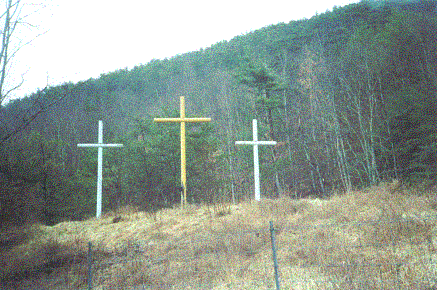
In English this becomes "To Dagobert II King and to Sion is the treasure
and it is there, Death." So, the parchment connects Sion and the lost Merovingian
Kings with some sort of treasure. The interesting point is the end of the French
phrase. With no punctuation, it is hard to tell whether it means "he is
dead," or "he is there dead." With the ambiguities, "it
is there, death" seems a more reasonable translation. However we read it,
there is a definite suggestion of a curse.
Nineteen
With the easy part behind them, and with some assurance that they were on
the right track, the next piece of the puzzle was a little more difficult. Its
decipherment led TO NOTHING LESS THAN THE STONE OF ZION AND THE HEART OF THE
MYSTERY.
 Nineteen
Nineteen
With the easy part behind them, and with some assurance that they were on
the right track, the next piece of the puzzle was a little more difficult. Its
decipherment led TO NOTHING LESS THAN THE STONE OF ZION AND THE HEART OF THE
MYSTERY.

So far, the strange M and triangle in the upper left corner has played little
part in the puzzle. Yet, it must be significant. When we do as the image suggests
and extend the lines of the triangle through the text, we find a pattern forming.
The upper line of the triangle passed through the first cross in the text in
line 4. The lower line appears to hit nothing significant until it strikes the
final N in the bottom line. This N seems to be part of a pattern.
Our code word, Sion, in the final four end lines of the text, is part of
that pattern. The last five letters of the text are SINON, with the central
N the terminus point of the lower triangle line. If we remove this letter, we
have of course another use of the key word, Sion. However, if we draw a line
from the terminus point of the upper line, the first cross, and the lower, the
N, we also spell out Sion with the letters the line passes through, for the
third use of the key word.
This is indeed curious. Three times 190, Sion spelled in full in Hebrew,
is 570, a factor of 57, ZN, or Zion, and the number of THE HEBREW WORD GATE
OR DOOR, AS IN THE GATE TO THE UNDERWORLD. Also the line from the N to the first
cross passes between two displaced O's, as if givinhe text are SINON, with the central
N the terminus point of the lower triangle line. If we remove this letter, we
have of course another use of the key word, Sion. However, if we draw a line
from the terminus point of the upper line, the first cross, and the lower, the
N, we also spell out Sion with the letters the line passes through, for the
third use of the key word.
This is indeed curious. Three times 190, Sion spelled in full in Hebrew,
is 570, a factor of 57, ZN, or Zion, and the number of THE HEBREW WORD GATE
OR DOOR, AS IN THE GATE TO THE UNDERWORLD. Also the line from the N to the first
cross passes between two displaced O's, as if giving a hint of sighting or aligning
with a distant point, the first cross.

And these gates shall not prevail against you...
Parchment One has given us the first indication of a geometry at the core
of the mystery. The Sion line forms the base of the triangle extending from
the upper left corner, as if it were a projection. This unusual 50/60/70 degree
triangle expands from the upper left corner to provide two fixed points, the
first cross and the N of SINON. We can find the center of this irregular triangle
by bisecting the angles...
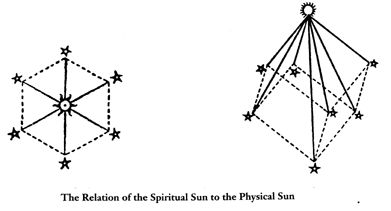
Six, the physical sun, Seven, the spiritual Sun.
Bisecting the angles exactly in half.
When we do, we find our first geometric oddity. The line from the first
cross in line 4 to the second cross in line 7 crosses the bisection line from
the 70 degree angle above the center point. This second center, pointed out
by the parchment itself, has the unusual property of being the point where two
concentric circles can be drawn, a large one which contains the smaller triangle,
and a smaller one which contains our fixed points.

Six, the physical sun, Seven, the spiritual Sun.
Bisecting the angles exactly in half.
When we do, we find our first geometric oddity. The line from the first
cross in line 4 to the second cross in line 7 crosses the bisection line from
the 70 degree angle above the center point. This second center, pointed out
by the parchment itself, has the unusual property of being the point where two
concentric circles can be drawn, a large one which contains the smaller triangle,
and a smaller one which contains our fixed points, the 1st cross and the N of
SINON, and the base of the smaller triangle.
Bisecting the angles using clues from the Manuscript.
The precision of this quite clear. No other point will provide this concentric
circle pattern, and the parchment draws our attention to it with the connection
between the 1st and 2nd crosses. If we extend the bisection line of the 70 degree
angle to where it crosses our inner circle, then do the same for the line from
the 1st to the 2nd cross, and connect the points we have an irregular pentagram.
This image is truly striking and there can be doubt about the correctness and
simplicity of the steps required to compose it. But when we have drawn it, we
are still left asking the same questions.
PENTAGONAL STAR GEOMETRY EMERGES.


YHVH (Yod HEH Vau HEH)
Three points are indicated as being important, the corners
of our projected triangle, and the unique center point for the concentric circles.
But why? We also have two alignments, the 70 degree bisection line and the 1st
to 2nd cross line. The third bisection line, from the required to compose it. But when we have drawn it, we
are still left asking the same questions.
PENTAGONAL STAR GEOMETRY EMERGES.


YHVH (Yod HEH Vau HEH)
Three points are indicated as being important, the corners
of our projected triangle, and the unique center point for the concentric circles.
But why? We also have two alignments, the 70 degree bisection line and the 1st
to 2nd cross line. The third bisection line, from the outer point of the smaller
triangle, strikes the O of SION line, and if we continue this line to the inner
circle, and connect the points, we have an irregular hexagram. But other than
underscoring the importance of the SION line, we are left still wondering why?
WHAT ARE WE SUPPOSED TO SEE HERE?
Twenty
We can think of the parchment as having layers of meaning. The surface layer
is the text itself and its alchemical parable. The next level warns us that
this "golden" wisdom is only for the sacred initiates. Then the text
reveals the hidden message: "To Dagobert the King, and to Sion, the treasure;
AND IT IS THERE, DEATH." The obscure device, the small triangle, in the
upper left leads us to its projection onto the text, suggesting that the next
level of meaning can be found through a geometric analysis. However, our expansion
of the projected triangle into a pentagram and a hexagram provides us little
further understanding. The six letters indicated by the complete hexagram do
tell us to NOTA M+, or note the M cross, perhaps a Mary or Magdalene cross,
but without more to go on this clue is also obscure.
However, there are also the three SIONs which come together to form a very
precise alignment. Everything we have discovered s
AND IT IS THERE, DEATH." The obscure device, the small triangle, in the
upper left leads us to its projection onto the text, suggesting that the next
level of meaning can be found through a geometric analysis. However, our expansion
of the projected triangle into a pentagram and a hexagram provides us little
further understanding. The six letters indicated by the complete hexagram do
tell us to NOTA M+, or note the M cross, perhaps a Mary or Magdalene cross,
but without more to go on this clue is also obscure.
However, there are also the three SIONs which come together to form a very
precise alignment. Everything we have discovered so far indicates THAT THE 3rd
SION LINE IS CRUCIAL, and it plays a significant role in forming the alignment.
Sighting along the 3rd SION line, between the two O's as if looking down a valley,
the line hits the base SION line at a 47 degree angle. In addition, the final
N in SINON marks the right angle between the 1st and 2nd SION lines. WE NOW
HAVE THREE LOCALITIES, the two N's and the O where the 1st and 3rd SION lines
intersect, in a precise geometric arrangement. And if we extend the 2nd SION
line beyond the N and through the Solis Sacerdotibus, we find our attention
drawn to the raised T, the final letter in MORT, from the hidden message. Could
this be the T or cross we have been told to note?
(Insert: RLC - Blanchefort sunrise line)
And yet, we are no closer to locating ourselves on the ground, and thereby
making any sense of the riddle. We might imagine that this was the empasse which
caused our conspirators to pause and argue over brandy that rainy fall afternoon
in 1887. Because at this point, the puzzle can only be resolved by reference
to alignments on the ground, the questions becomes: where do you begin?

Know that Summer is nigh...Matthew 24 (KJV).
(Insert: RLC - Blanchefort sunrise line)
And yet, we are no closer to locating ourselves on the ground, and thereby
making any sense of the riddle. We might imagine that this was the empasse which
caused our conspirators to pause and argue over brandy that rainy fall afternoon
in 1887. Because at this point, the puzzle can only be resolved by reference
to alignments on the ground, the questions becomes: where do you begin?

Know that Summer is nigh...Matthew 24 (KJV).
We can imagine that all three of our conspirators had an opinion on that
one. But, let us imagine that was the point where the lovely Marie spoke up
to tell her distinguished listeners THE STORY OF THE SUMMER SUNRISE FROM RENNES-LE-CHATEAU.
If you stand at the eastern edge of the cemetery and look back toward Pech
Cardu, on the longest day of the year, the sun rises so that the ruins of Chateau
Blanchefort are silhouetted against it. It feels as if a long shadow is reaching
out directly for the church here at Rennes. We can imagine her pausing, flushing
faintly as she gained their attention. And that's not all. Rennes and Blanchefort
are just two of the five old sacred places WHERE THE WISE WOMEN SAY THERE ONCE
WAS A TEMPLE TO THE VIRGIN. There's a hill not far away where you can see all
five of them. Does that help?
And so, after, we assume, a moment of stunned silence, our conspirators
began to all talk at once and crowd around the Abbe Boudet's carefully annotated
maps. Marie showed them her mountains, and with compass and protractor in hand,
they set to work. The pentagon of mountains turned out to be too regular to
be the pentagram derived from the parchment. This was disappointing, but it
led to the realization that the Rennes/Blanchefort alignment was key.
The temptatio of the five old sacred places WHERE THE WISE WOMEN SAY THERE ONCE
WAS A TEMPLE TO THE VIRGIN. There's a hill not far away where you can see all
five of them. Does that help?
And so, after, we assume, a moment of stunned silence, our conspirators
began to all talk at once and crowd around the Abbe Boudet's carefully annotated
maps. Marie showed them her mountains, and with compass and protractor in hand,
they set to work. The pentagon of mountains turned out to be too regular to
be the pentagram derived from the parchment. This was disappointing, but it
led to the realization that the Rennes/Blanchefort alignment was key.
The temptation is to see it as the 3rd SION line, with the N in SINON as
Blanchefort, but that yields no further significant alignments, and none with
the precise 47/43/90 degree angles described on the parchement. And then, with
a shift in thinking, it becomes clear that the 2nd SION line is the Rennes/Blanchefort
line. A little fiddling with the map reveals that Blanchefort is the corner
N of the 90 degree angle. The line extends beyond Blachefort to Arques, which
we can think of as the S in SINON. Extending the line in the other direction
brings us to our "noted" T, which then becomes Rennes-le-Chateau.
So far so good, but the test is in the angles. Is there a point that makes
a 90 degee angle to Blanchefort. Yes indeed, Rennes-le-Bains itself is a few
miles due south of Blanchefort, so our first angle works. The line from Rennes
to Arques crosses the Paris Meridan, the Zero meridan line of France, near the
so-called Poussin's tomb. Sighting from that point back toward Rennes-le-Bains
creates a 47 degree angle, making the meridan crossing the middle N of SINON.
We can extend the alignments on the 3rd SION line by exactly one mile from the
crossing and Rennes-le-Bains. One mile beyond the crossing point is an ancient
megalithic standing stone. One mile beyond Rennes-le-Bains is another area of
megales. Is there a point that makes
a 90 degee angle to Blanchefort. Yes indeed, Rennes-le-Bains itself is a few
miles due south of Blanchefort, so our first angle works. The line from Rennes
to Arques crosses the Paris Meridan, the Zero meridan line of France, near the
so-called Poussin's tomb. Sighting from that point back toward Rennes-le-Bains
creates a 47 degree angle, making the meridan crossing the middle N of SINON.
We can extend the alignments on the 3rd SION line by exactly one mile from the
crossing and Rennes-le-Bains. One mile beyond the crossing point is an ancient
megalithic standing stone. One mile beyond Rennes-le-Bains is another area of
megaliths.
Therefore, we can now begin to locate the puzzle on the ground. By using
the SION line geometry, we have identified six locations noted in the parchment:
The T is Rennes-le-Chateau, the N is Blanchefort, the second N is the crossing
point and the S is Arques. Blanchefort is the intersection of SION lines one
and two, and the crossing point is the intersection of SION lines 2 and 3. The
O of the 1st SION line is Rennes-le-Bains and the second cross in the 3rd SION
line is the megalithic area southwest of Rennes-le-Bains.
Using the line from the Rennes-le-Chateau T to the Blanchefort N as one
side of a pentagon formed from the old mountain-top sacred sites, we can fill
in the rest of the figure. It covers the area of the text that is most irregular
in line length, including the Redis Bles, and is centered on a strange area
around the 3rd cross and the O of the 3rd SION line. However, this pentagon/gram
seems to give us no help in identifying the other two points of the original
projected triangle. All we have is one of the three points, the crossing of
the SION lines 2 and 3, which falls on the Paris Meridian.
But, the 3rd SION line passes through the central area of the pentagram
with its significant cross and O. We also have the T in the Rennes-le-Chateau
p from the old mountain-top sacred sites, we can fill
in the rest of the figure. It covers the area of the text that is most irregular
in line length, including the Redis Bles, and is centered on a strange area
around the 3rd cross and the O of the 3rd SION line. However, this pentagon/gram
seems to give us no help in identifying the other two points of the original
projected triangle. All we have is one of the three points, the crossing of
the SION lines 2 and 3, which falls on the Paris Meridian.
But, the 3rd SION line passes through the central area of the pentagram
with its significant cross and O. We also have the T in the Rennes-le-Chateau
position which can also be used as a sighting point. Indeed, when we sight from
the base of the T to the base of the cross in the 3rd SION line, the extended
line strikes the peculiar extended corner of the small triangle in the upper
left corner. When we look at the angle indicated by this extended corner, we
find that it is 72 degrees, a pentagonal corner angle just as is the T from
which it was sighted. We may take this as some confirmation of the importance
of this alignment.
There are other alignments, many of them, possible from the T or Rennes-le-Chateau
point. One passes through the N of the SION in the hidden text and points to
the first T in the main text. Another passes through the O in the 3rd SION line
and points to the O just before the raised A in line two. A third connects the
lonely second cross in line 7. However, the PS encircled with a loop, as on
Marie de Blanchefort's gravestone, gives a clue as to the what might be the
most important alignment. A line through the center of the PS, angled so as
to touch both letters, passes through the base of the T and continues through
the cross to the peculiar corner of the small triangle. Along the way, it spells
out a message.
As on the gravestone, the PS with a loop is a symbol for OR, gold, in French.
Following thrst T in the main text. Another passes through the O in the 3rd SION line
and points to the O just before the raised A in line two. A third connects the
lonely second cross in line 7. However, the PS encircled with a loop, as on
Marie de Blanchefort's gravestone, gives a clue as to the what might be the
most important alignment. A line through the center of the PS, angled so as
to touch both letters, passes through the base of the T and continues through
the cross to the peculiar corner of the small triangle. Along the way, it spells
out a message.
As on the gravestone, the PS with a loop is a symbol for OR, gold, in French.
Following the line we find TER+A, or terra, earth. This gives us gold earth
or ore, at the peculiar triangle point. A slight displacement of 5 degrees shifts
the line to the top point of the extended angle of the small triangle and passes
through the center of the cross in the 3rd SION line while still emphasizing
the same letters. This makes the message, and the location it is pointing to,
even more significant.
Twenty One
Going from right to left from the T at Rennes-le-Chateau, we find an alignment
to the first cross at the head of the 3rd SION line, an alignment with the O,
the cross and the N. The markers on the 3rd SION line appear to be sighting
points for the T at Rennes-le-Chateau. Apparently, the only significant alignment
not marked on the 3rd SION line is the line to the 2nd cross in line 7. That
gives us five major sight lines indicated by the parchment aligned on the T
or cross at Rennes-le-Chateau, only one of which gives us a clear message: Gold
Ore Here. The importance of the point of the triangle indicated by the extended
angle grows when we connect it with our odd-ball 2nd cross. It hits the 2nd
cross at a 90 degree angle after passing through three other T's. This mimics
the alignments from the Rennes point, which has the three T's or crosses of
the 3rd SION line appear to be sighting
points for the T at Rennes-le-Chateau. Apparently, the only significant alignment
not marked on the 3rd SION line is the line to the 2nd cross in line 7. That
gives us five major sight lines indicated by the parchment aligned on the T
or cross at Rennes-le-Chateau, only one of which gives us a clear message: Gold
Ore Here. The importance of the point of the triangle indicated by the extended
angle grows when we connect it with our odd-ball 2nd cross. It hits the 2nd
cross at a 90 degree angle after passing through three other T's. This mimics
the alignments from the Rennes point, which has the three T's or crosses of
the 3rd SION line, and the final cross, the second cross in line 7. In addition,
the angles of the three crosses, 1 and 2 with the Rennes cross, form the base
triangle of another regular pentagon/gram, #3, which can be completed with alignments
from the Rennes T. Now, let's try to put this in order and see what it tells
us. Projecting the small triangle over the text gives us the 3rd SION line as
the base of the projected triangle. We are directed to the unique center point
by the line from the 1st cross to the second. Using this center to draw two
concentric circles allows us to create Pentagram #1, the irregular pentagram.
Developing this figure however leads us to a virtual dead end.
The SION alignments locate us in space, ALONG THE SUMMER SUNRISE ALIGNMENT
from Rennes to Blanchefort and the crossing point of the Paris Meridian, its
angular relationship to Rennes-le-Bains and the 3rd cross in line 10. From this,
we can develop the regular Pentagram #2. While this locates us in space by defining
the Rennes-le-Chateau corner of the pentagram as a sighting point, it proves
unhelpful in identifying the other locations. But locating the T in MORT as
Rennes-le-Chateau does allow us to use it as a sighting point with which to
align the PS and the 3rd cross with the oddly accented corner of the small triangle.
We cvirtual dead end.
The SION alignments locate us in space, ALONG THE SUMMER SUNRISE ALIGNMENT
from Rennes to Blanchefort and the crossing point of the Paris Meridian, its
angular relationship to Rennes-le-Bains and the 3rd cross in line 10. From this,
we can develop the regular Pentagram #2. While this locates us in space by defining
the Rennes-le-Chateau corner of the pentagram as a sighting point, it proves
unhelpful in identifying the other locations. But locating the T in MORT as
Rennes-le-Chateau does allow us to use it as a sighting point with which to
align the PS and the 3rd cross with the oddly accented corner of the small triangle.
We can't go too far wrong by supposing that this is one of the most significant
alignments on the parchment. However, we still have only one point, Rennes-le-Chateau,
identified. Using the angle defined by the supposed Rennes/Blanchefort line,
45 degrees, we find no significant alignments on the map. Using the length as
a relative distance marker brings us to nothing but bare mountain side. Either
something is wrong with our alignment, which hardly seems likely, or something
is wrong with our assumptions about the angle and distance from Rennes-le-Chateau
to Blanchefort. As we mull it over, the assignment of places to the intersection
of the SION lines SEEMS TO BE PURELY SYMBOLIC, pointing to the pattern of angular
ratios, without specifying exact spatial relationships. Blanchefort is not located
by the final N in SINON, it is merely symbolized by the N. The same with the
N of the meridian crossing point: its location is symbolic within the angular
pattern. So where are these places? Does the parchment tell us? Indeed it does.
Pentagrams #1 and #2, while clearly indicated on the parchment, do little to
help us locate any single spot on the ground. They do provide a series of co-ordinating
points, which require the development of Pentagram #3 in order to become actual
spatial relationships.
The way thi BE PURELY SYMBOLIC, pointing to the pattern of angular
ratios, without specifying exact spatial relationships. Blanchefort is not located
by the final N in SINON, it is merely symbolized by the N. The same with the
N of the meridian crossing point: its location is symbolic within the angular
pattern. So where are these places? Does the parchment tell us? Indeed it does.
Pentagrams #1 and #2, while clearly indicated on the parchment, do little to
help us locate any single spot on the ground. They do provide a series of co-ordinating
points, which require the development of Pentagram #3 in order to become actual
spatial relationships.
The way this is coded on the parchment is nothing short of genius. Whoever
designed this was a master puzzle maker. The problem is that the pentagonal
pattern on the ground must be modeled on the parchment in such a way as to represent
actual spatial relationships. Pentagram #2 is regular enough to be the pentacle
of mountain tops, but the spatial ratios don't match. If the last N in the SINON
line is Blanchefort, then the N of the meridian crossing is too close in relation
to the distance between Rennes and Blanchefort. The same applies to finding
Rennes-le-Bains in relation to the N as Blanchefort: the distances don't match
the map. Let me note however that if we stay in the immediate area of the 47
degree SION line alignments, the scale itself is accurate. The 3rd cross point,
in this scale, falls on the intersection of the 3rd SION line and the inner
line of Pentagram #2. The ratios are accurate, we just haven't found the right
scale. However, we have tentatively identified the T in saceradotibus, sacred
initiates, as Rennes-le-Chateau. On the face of it, this makes sense, and none
of the problems with scale effect our choice of this point. Therefore let us
assume that this is our one clearly located point, and that the alignments from
that point along the 3rd SION line are significant. As noted above, there are
fivay in the immediate area of the 47
degree SION line alignments, the scale itself is accurate. The 3rd cross point,
in this scale, falls on the intersection of the 3rd SION line and the inner
line of Pentagram #2. The ratios are accurate, we just haven't found the right
scale. However, we have tentatively identified the T in saceradotibus, sacred
initiates, as Rennes-le-Chateau. On the face of it, this makes sense, and none
of the problems with scale effect our choice of this point. Therefore let us
assume that this is our one clearly located point, and that the alignments from
that point along the 3rd SION line are significant. As noted above, there are
five major alignments suggested by the 3rd SION line from the Rennes-le-Chateau
T. Four remain the same, but the fifth, from Rennes to the final N in SINON
is clearly inaccurate. All five of these alignments are used to create Pentagram
#3. Connecting alignments 1 and 4 with the line from the 1st to the 2nd cross
in the text gives us the geometric basis of the pentagram, a 36/72/72 degree
triangle. Alignment 2, through the O's, points to the top point of the pentagram
developed from the triangle of crosses. Alignment 3, the Gold Ore Here line,
passes through a corner angle of the pentagram as an accuracy marker. The fifth
alignment is the new line to Blanchefort and falls on the continuation of the
3rd SION line. This pentagram, #3, allows us to precisely locate the pentacle
of mountain tops by means of sight lines from Rennes-le-Chateau. In addition,
when we extend the Rennes/Blanchefort line to the point where it crosses the
vertical line from the odd corner of the small triangle, through three T's and
the 2nd cross, we find that we have an accurate distance ratio between our three
points, Rennes, Blanchefort and the meridian crossing point. This check assures
us that we have found the right pentagram alignments. When we place these alignments
on the map, something immediately jumps out at us. The odd point of thert and falls on the continuation of the
3rd SION line. This pentagram, #3, allows us to precisely locate the pentacle
of mountain tops by means of sight lines from Rennes-le-Chateau. In addition,
when we extend the Rennes/Blanchefort line to the point where it crosses the
vertical line from the odd corner of the small triangle, through three T's and
the 2nd cross, we find that we have an accurate distance ratio between our three
points, Rennes, Blanchefort and the meridian crossing point. This check assures
us that we have found the right pentagram alignments. When we place these alignments
on the map, something immediately jumps out at us. The odd point of the small
triangle falls on the ancient gold mine at Bugarach. Indeed, the ruined chateau,
the ancient mine and an equally antique spring and reservoir form our 50/60/70
degree triangle, as indicated on the parchment. An ancient gold mine, perhaps
even the fabled Pyrene of Herodotus, is certainly indicated by a line that reads
Gold Ore Here on the parchment. Could this be the secret? Hardly, because the
mine itself has been located since Roman times. Pomponnius Mela identified it
around the time of the Consul Caepio who looted the treasure of Toulouse. Locating
the gold mine is important, BUT IT CAN'T BE THE SECRET ITSELF. TO LOCATE THAT
WE NEED THE STONE OF ZION.
Twenty Two
There is one last alignment from the T at Rennes which we haven't yet examined.
It runs from the T, through the Redis Bles, then through the cross bar of the
final N in the Sion of the hidden text, then on through the unique center point
to the first T in the main text. This line gives us the letters T, S, E, I,
N, and passes between the 3rd cross and the O in the 3rd SION line. Including
these, we now have Et SION +, or "and (to) SION (the) cross." This
of course echoes the hidden text, "AND TO SION IS THE TREASURE," LEADING
US TO CONNECT THE CROSS, (but which one?) WITH THE TROF ZION.
Twenty Two
There is one last alignment from the T at Rennes which we haven't yet examined.
It runs from the T, through the Redis Bles, then through the cross bar of the
final N in the Sion of the hidden text, then on through the unique center point
to the first T in the main text. This line gives us the letters T, S, E, I,
N, and passes between the 3rd cross and the O in the 3rd SION line. Including
these, we now have Et SION +, or "and (to) SION (the) cross." This
of course echoes the hidden text, "AND TO SION IS THE TREASURE," LEADING
US TO CONNECT THE CROSS, (but which one?) WITH THE TREASURE. We now have five
repetitions of the key word. The fourth is in line 9, the SION hidden in the
text, and the fifth is the convoluted occult SION of the T to T line. Three
of these five lines intersect in a triangle composed of the final N in line
9, and the 3rd cross and O of the 3rd SION line. The other two Sion lines form
a right angle base from which a rectangle can be formed that defines the isosceles
triangle of the N, the O and the 3rd cross. A wealth of esoteric science is
revealed by these five SION lines. The 5th SION line is like an arrow head pointing
to the first T in the text by sighting ON THE UNIQUE CENTER POINT. Why?
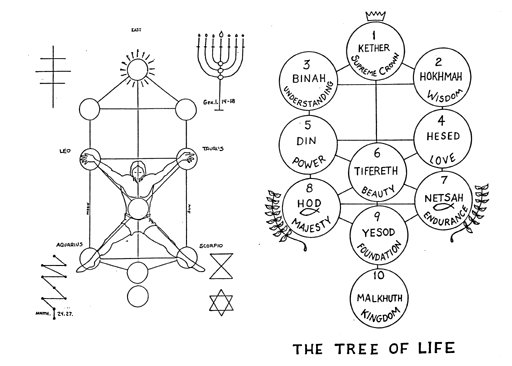
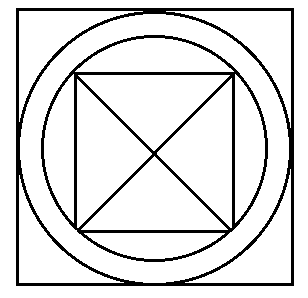
The location on the ground of that T IS UNDOUBTEDLY THE X OR T MARKS THE
SPOT WHERE WE SHOULD BEGIN TO LOOK FOR THE PLACE WHERE THE SECRET, OR THE TREASURE,
IS HIDDEN. To find it though, we must triangulate from Rennes, the ancient gold
mine at the odd corner point and the locality of the 1st cross. If the point
which falls off the parchment is Blanchefort, the 1st cross is Serre de Lauzet.
Unfortunately, the line from the mine to the 1st cross at Serre de Lauzet is
straight. Which means that e="center">

The location on the ground of that T IS UNDOUBTEDLY THE X OR T MARKS THE
SPOT WHERE WE SHOULD BEGIN TO LOOK FOR THE PLACE WHERE THE SECRET, OR THE TREASURE,
IS HIDDEN. To find it though, we must triangulate from Rennes, the ancient gold
mine at the odd corner point and the locality of the 1st cross. If the point
which falls off the parchment is Blanchefort, the 1st cross is Serre de Lauzet.
Unfortunately, the line from the mine to the 1st cross at Serre de Lauzet is
straight. Which means that everything depends on determining the angle at which
the 5th SION line crosses the line from the mine to the 1st cross. An error
from Rennes of a few degrees could mean hundreds of yards on the ground. The
only assurance of accuracy was to find some kind of marker at the N point in
the 4th SION line that precisely defined the angle of intersection. The parchment
suggests that something like this exists. The angle of the line precisely matches
the cross bar of the N, and if only something marked this on the ground, then
the precise location of the initial T, and the treasure, could be found.
And so, our four conspirators set off the next morning to find the marker
stone. Since this is imagination, let us envision a beautiful fall day, with
brilliantly clear sunlight and a rain-washed atmosphere that allows one to see
for miles. It is also a fine day for a picnic. A few miles of tramping across
the countryside brings them to the general location of the N on the parchment.
They spread out to search and soon one of them finds what they are looking for:
the Zion stone. A few hundred yards northwest of the Coume-Sourde farmhouse
and perhaps covering the springhead of Coume-Sourde creek, was a strange flat
stone with a geometric carving and a few words in simple and ambiguous Latin.
A check with a compasso find the marker
stone. Since this is imagination, let us envision a beautiful fall day, with
brilliantly clear sunlight and a rain-washed atmosphere that allows one to see
for miles. It is also a fine day for a picnic. A few miles of tramping across
the countryside brings them to the general location of the N on the parchment.
They spread out to search and soon one of them finds what they are looking for:
the Zion stone. A few hundred yards northwest of the Coume-Sourde farmhouse
and perhaps covering the springhead of Coume-Sourde creek, was a strange flat
stone with a geometric carving and a few words in simple and ambiguous Latin.
A check with a compass and a tracing of the parchment reveals that this is the
key, an arrow pointing to the secret. Today, the Zion or Coume-Sourde stone
can be seen to the left of the door as one enters the presbytery from the courtyard
at Rennes. Like so many clues, it has been defaced, probably by Sauniere in
the dark years. One of his friends, the engineer and amateur archeologist Ernest
Cros, protested this mutilation, and his sketches are our only source for both
the Zion stone and Marie de Blanchefort's gravestone. To Sauniere however, its
location and placement were the real clues. Without them the triangle and the
inscription are meaningless. The stone is a rough square, six inches thick about
two feet in height and width. On its surface, according to Mr. Cros' sketch,
was a 50/65/65 degree triangle enclosing another smaller triangle, this one
36/36/108 degrees, with a contiguous base line. There was a cross at the apex
of both triangles and a Latin inscription that reads" "In medio Linae
ubi M secat - Linae parva - P.S Praecum." It is hard to derive a meaning
from these fragmented and ungrammatical Latin phrases. The best we can do is:
"In the middle (of) the line where M (is) isolated - line (through) space
- P.S before/with." Also, at the upper corners, were the letters SAE and
SIS, which seeme, six inches thick about
two feet in height and width. On its surface, according to Mr. Cros' sketch,
was a 50/65/65 degree triangle enclosing another smaller triangle, this one
36/36/108 degrees, with a contiguous base line. There was a cross at the apex
of both triangles and a Latin inscription that reads" "In medio Linae
ubi M secat - Linae parva - P.S Praecum." It is hard to derive a meaning
from these fragmented and ungrammatical Latin phrases. The best we can do is:
"In the middle (of) the line where M (is) isolated - line (through) space
- P.S before/with." Also, at the upper corners, were the letters SAE and
SIS, which seem to have no direct meaning as words.
Perhaps they are initials or code, in which case we are reminded of the
ISIS mid-point on Marie de Blanchefort's gravestone. They probably represent
the 3rd cross and O points from the 3rd SION line on the parchment, and on the
ground serve as markers for the Zion stone, which is probably represented by
the cross at the apex of the internal triangle. In which case, the second cross
on the Zion stone, by extension, points to the initial cross on the parchment,
and the location of the treasure or secret. If the alignment of crosses on the
Zion stone matched the angle of the N in the hidden SION in its original placement,
then that would allow Sauniere and the others to take a precise reading of the
T's location. The stone itself says: that the spot is "in the middle of
the line where the M is isolated." If we think of the isolated M as the
M above the small triangle, then what "line" are we talking about?
If we draw a line from the upper most tip of the extended angle on the small
triangle, the point closest to the M, through the top point of pentagram #3,
it also defines a backstop point beyond the initial T which falls on the exact
mid point of the line, the isolated M line, the line that passes through "space"
rather than through placement,
then that would allow Sauniere and the others to take a precise reading of the
T's location. The stone itself says: that the spot is "in the middle of
the line where the M is isolated." If we think of the isolated M as the
M above the small triangle, then what "line" are we talking about?
If we draw a line from the upper most tip of the extended angle on the small
triangle, the point closest to the M, through the top point of pentagram #3,
it also defines a backstop point beyond the initial T which falls on the exact
mid point of the line, the isolated M line, the line that passes through "space"
rather than through the text. The PS Praecum tells us that the secret, before/with,
of the gold can be found there. Equally as interesting, if we think of the T
of MORT, Rennes, as the pommel of the MORT epee of Marie de Blanchefort's headstone,
then the Zion stone becomes the hilt, with the initial T as the point. The place
where the Zion stone was found is called Coume-Sourde, which in French might
be translated as Sleepy Hollow, and which sounds as if it were Cum-a- Sword,
or "with a sword." It has the added Green Language twist of being
a hollow or invisible sword from the connotations of the French word "sourde."
Simply follow the hollow or invisible Mort line of the Epee on the ground and
you will find the missing T, or cross, which marks the treasure. We can be sure
that our group did just that, and soon arrived at the point on the ground. Once
there, they only had to follow the directions given in the final decoding of
the second parchment and its anagram on the headstone to find the exact location
of the treasure. Once found however, the real work began. With the missing T
of D'Haupol located, the next step was to apply the message found in the second
parchment.
This parchment was also a botched selection from the Bible, this time from
the Gospel of John. The text is from John 12: 1- 11 -ort line of the Epee on the ground and
you will find the missing T, or cross, which marks the treasure. We can be sure
that our group did just that, and soon arrived at the point on the ground. Once
there, they only had to follow the directions given in the final decoding of
the second parchment and its anagram on the headstone to find the exact location
of the treasure. Once found however, the real work began. With the missing T
of D'Haupol located, the next step was to apply the message found in the second
parchment.
This parchment was also a botched selection from the Bible, this time from
the Gospel of John. The text is from John 12: 1- 11 -- the Bethany sequence
with Mary and Martha is interesting in its own right -- and contains 140 extra
letters. The center 12 of these letters spelled out "Ad Genesareth,"
OR LITERALLY,"TO THE EARTH SOURCE." It is also the Hebrew name for
the sea of Galilee. When we remove these 12 letters, we are left with 128, the
number of letters on Marie de Blanchefort's headstone plus the PS Praecum. By
a series of permutations, involving the Vigenere table and the Knight's tour
of two chess boards, these extra letters are transformed into a relatively clear
message. The original is French, and an English translation reads: "Shepherdess
no temptation that Poussin Teniers hold the key - peace 681 by the cross and
this horse of God I complete (or destroy) this Daemon Guardian at midday Blue
Apples." As I say, this is relatively clear, but is actually only indirectly
meaningful, a possible red herring that must be checked out. It is however a
perfect anagram for Marie de Blanchefort's headstone plus the PS Praecum. In
order to get the correct directions, one must use the same code pattern with
the key words of REX MUNDI, which is spelled out in odd small letters on the
second parchment, and the 46 letters on the gravestone (Et in+ Arca+dio Ego
- PS - Reddis Regis Arcis Cellis - Praecum), plus ttemptation that Poussin Teniers hold the key - peace 681 by the cross and
this horse of God I complete (or destroy) this Daemon Guardian at midday Blue
Apples." As I say, this is relatively clear, but is actually only indirectly
meaningful, a possible red herring that must be checked out. It is however a
perfect anagram for Marie de Blanchefort's headstone plus the PS Praecum. In
order to get the correct directions, one must use the same code pattern with
the key words of REX MUNDI, which is spelled out in odd small letters on the
second parchment, and the 46 letters on the gravestone (Et in+ Arca+dio Ego
- PS - Reddis Regis Arcis Cellis - Praecum), plus the 11 letters (Th is one
letter in Hebrew) of AD GENESARETh for a total of 57, ZN or Zion. This is repeated
twice, leaving a 14 letter gap that is filled by Solis Redis Bles. When we complete
the process, a new message appears. It reads, in English as: "Native Roman
Gold - Hautpol - Deposits: Visigothic Alaric Royal - Templars Bezu - access
karst south Aven rays LLLLLLXV.M (315) points Aven - P. carla - Roi Mort (dead
king) MMLLLLXLV.M (2,245)." While this is still rather mysterious, at least
now we have distances to measure from th small hilltop village of Serrat Cremat,
a name which seems to mean Forced Cremation, or Sabbath Bonfire in te M cross.
Applying this on the ground leads to a small cave opening a few hundred yards
down the slope from thehe local dialect. Near the cave area are the ruins of
Chateau Hautpol destroyed by Simon de Montfort, who sent the entire garrison
and all the occupants of the fortress to the stake, hence the village's unusual
name. The cave opening can be seen on the parchment, below and to the right
of the initial T, which we can think of as the missing T in D'Haupol on Marie
de Blanchefort's headstone. It is the only O with a center point, marking an
entrance perhaps. Eventually we can be sure that our conspirators made it to
this point and explored the cave. Since nos.
Applying this on the ground leads to a small cave opening a few hundred yards
down the slope from thehe local dialect. Near the cave area are the ruins of
Chateau Hautpol destroyed by Simon de Montfort, who sent the entire garrison
and all the occupants of the fortress to the stake, hence the village's unusual
name. The cave opening can be seen on the parchment, below and to the right
of the initial T, which we can think of as the missing T in D'Haupol on Marie
de Blanchefort's headstone. It is the only O with a center point, marking an
entrance perhaps. Eventually we can be sure that our conspirators made it to
this point and explored the cave. Since none of the group has left us any direct
evidence, we can only evaluate the significance of that find by looking at what
happened next.
Twenty Three
It must have taken the group a few months to complete their find and assess
its importance. By the spring of 1888, however, things were beginning to move.
Johann renewed his contacts with various occult and chivalric orders, and, most
important of all, he reconnected with his cousin, the Crown Prince Rudolph of
Austria-Hungary. Rudolph, six years younger than Johann and Sauniere, was an
unhappy, frustrated and idealistic young liberal heir to a vast, conservative
AND ABOVE ALL CATHOLIC EMPIRE. In 1888 Rudolph turned 30, and his father --
Franz Joseph had been on the throne for forty years -- showed no inclination
toward sharing authority or including his son in the workings of government.
This, in many ways, was the crowning frustration of a tortured and disturbed
life. As a young boy, Rudolph's tutor, the Count Gondrecourt, bullied and abused
him in a misguided attempt to toughen his nerve. Fortunately, his mother, the
Empress Elizabeth intervened. It was perhaps the only really kind thing she
ever did for her son. Elizabeth, an intelligent and sensitive person caught
in a loveless marriage and the internal intrigues of t ABOVE ALL CATHOLIC EMPIRE. In 1888 Rudolph turned 30, and his father --
Franz Joseph had been on the throne for forty years -- showed no inclination
toward sharing authority or including his son in the workings of government.
This, in many ways, was the crowning frustration of a tortured and disturbed
life. As a young boy, Rudolph's tutor, the Count Gondrecourt, bullied and abused
him in a misguided attempt to toughen his nerve. Fortunately, his mother, the
Empress Elizabeth intervened. It was perhaps the only really kind thing she
ever did for her son. Elizabeth, an intelligent and sensitive person caught
in a loveless marriage and the internal intrigues of the imperial court, virtually
abandoned Rudolph, taking long tours abroad to escape the stifling atmosphere
in Vienna. Rudolph of course had no escape. A marriage had been arranged in
1881 to Stephanie of Belgium, which turned out to be a disaster. Stephanie was
a dull but cheerful child. They were betrothed when she was fifteen and the
wedding had to be postponed until she began to menstruate. Rudolph was smitten
at first with her simple beauty, but soon tired of her. A series of affairs
developed, including a liaison with the dancer Mitzi Kasper. By the time he
turned thirty in 1888, Rudolph's brilliance had begun to turn wild. Rudolph
and Johann would be in continual contact for the next eight months until Rudolph's
death. While the great secret, or even Rennes-le-Chateau, is never mentioned,
there is evidence that Johann and Rudolph were planning some sort of coup. In
the fall of 1888, Rudolph almost shot his father, Franz Joseph, "accidentally"
on the hunting field. Rudolph was asked to leave for the day and the matter
was hushed up. It was also the last time Franz Joseph saw his son alive. On
January 30th 1889, Rudolph and his current mistress, Maria Vetsera, were found
dead in the Imperial hunting lodge at Mayerling. Rumors leaked out that it was
a suicide pact between the lovers. This was sca be in continual contact for the next eight months until Rudolph's
death. While the great secret, or even Rennes-le-Chateau, is never mentioned,
there is evidence that Johann and Rudolph were planning some sort of coup. In
the fall of 1888, Rudolph almost shot his father, Franz Joseph, "accidentally"
on the hunting field. Rudolph was asked to leave for the day and the matter
was hushed up. It was also the last time Franz Joseph saw his son alive. On
January 30th 1889, Rudolph and his current mistress, Maria Vetsera, were found
dead in the Imperial hunting lodge at Mayerling. Rumors leaked out that it was
a suicide pact between the lovers. This was scandalous enough to quell any further
investigation, and might just have been a smoke-screen. It is possible that
Rudolph posed such a threat to the Empire THAT HE WAS KILLED BY THE IMPERIAL
SECRET SERVICE. There are many suggestive pieces of evidence for this conclusion,
but for our purposes, the most important concerns the Archduke Johann. In the
days before his death, Rudolph entrusted to the Countess Larisch, one of his
admirers and the one who introduced him to Maria, a locked steel box with the
instruction to give it only to the person who gave the code word: RIOU. This
is of course a contraction of the House of Austria's motto ; "Austria est
Imperare Orbi Universo," into perhaps "Rudolph Imperare Orbi Universo,"
or even "Rhedae Imperare Orbi Universo." On the day of Rudolph's funeral,
the Countess received a message with the code word. As instructed, she later
that night met a man whom she recognized as the Archduke Johann. He took the
steel box and told her it contained secrets so dire that if Franz Joseph caught
a whiff of it, they would all be shot. We might dismiss this as mere "Prisoner
of Zenda" melodrama, except that there is independent confirmation of the
box's existence. Johann renounced his title in the weeks after Rudolph's funeral.
He also bought a shimperare Orbi Universo," into perhaps "Rudolph Imperare Orbi Universo,"
or even "Rhedae Imperare Orbi Universo." On the day of Rudolph's funeral,
the Countess received a message with the code word. As instructed, she later
that night met a man whom she recognized as the Archduke Johann. He took the
steel box and told her it contained secrets so dire that if Franz Joseph caught
a whiff of it, they would all be shot. We might dismiss this as mere "Prisoner
of Zenda" melodrama, except that there is independent confirmation of the
box's existence. Johann renounced his title in the weeks after Rudolph's funeral.
He also bought a ship and studied for his master's certificate in navigation.
On March 26, 1890, Captain Johann Orth sailed the St. Margaret for South America.
His mistress, Milli Stubel, joined him in Buenos Aires and on July 12, they
set off around Cape Horn. They were never officially seen again. Years later,
Milli's sister told her story to a Viennese newspaper and confirmed the existence
of the steel box. Johann gave it to Milli for save keeping and she took it with
her when she left for South America. It was filled with documents in code, the
sister noted. Could Johann and Rudolph have attempted a sort of inside coup,
threatening Franz Joseph, pressuring him to step aside in favor of Rudolph?
The one intriguing point is the connection of Johann and the steel box.
His significance in the story is unclear without the connection to Rennes. The
coded documents could have been the proofs worked out above pointing to the
treasure site near Bugarach. What about these documents would have meant death
to Rudolph and Johann? What is it about this treasure that makes its possessors
feel that they are power players in western politics? Johann and Rudolph misjudged
the reaction. They felt entitled, and therefore never saw it coming. Once Rudolph
was dead and discredited, the plan was over. Johann renounced his title, went
in favor of Rudolph?
The one intriguing point is the connection of Johann and the steel box.
His significance in the story is unclear without the connection to Rennes. The
coded documents could have been the proofs worked out above pointing to the
treasure site near Bugarach. What about these documents would have meant death
to Rudolph and Johann? What is it about this treasure that makes its possessors
feel that they are power players in western politics? Johann and Rudolph misjudged
the reaction. They felt entitled, and therefore never saw it coming. Once Rudolph
was dead and discredited, the plan was over. Johann renounced his title, went
into exile, and disappeared. Whatever their plan, it was blown. And the Austrian
secret service was aware of a deadly secret in Rennes-le-Chateau. In a reaction
so violent that an heir to the throne is killed, we can be sure that such loose
ends as the source of the secret would also be attended to. First, an attempt
would be made to silence them by force, and then, if that failed, an attempt
at negotiation would be offered. Eventually, an accommodation would be reached,
and the secret would be kept. Such in fact was exactly what happened.
Twenty Four
Sauniere was warned, either by the fact of Rudolph's death or by a visit
from Johann before he disappeared. The Abbe spent the year after Johann's departure
in the small village of Antugnac, near his home in Montazels. We might suggest
that the good Abbe was in hiding. However, by the spring of 1891, Sauniere was
back in Rennes-le-Chateau with big plans. On June 21, he staged a procession
through the village with a statue of the Virgin of Lourdes, which he then had
installed on the Visigothic pillar in the garden of the church. This dedication
to the Virgin kicked off another round of restoration, which in September resulted
in the finding of a tomb and a treasure, all mysteriously stage-managed by Sauniere.
The Mission 1891 carved on the new base of the Visigothic pillar suggests that
Sauniere had indeed embarked on a mission to get the information out. Or at
least part of the secret. Mission 1891 started with the staged discovery of
the tomb, perhaps the same one found in the summer of 1887, and a careful distribution
of the genealogies and the parchments. First, the verger found a vial with a
letter from the Abbe Bigou's uncle giving clear directions where to look for
the tomb of Sigisbert IV. The directions were followed and a tomb containing
Merovingian relics were found, just where the register of 1694 mentions the
tomb of the "Seigneurs de Rennes." A few days later, a group of local
dignitaries, including engineer Cros, the Abbe Gelis of Couiza, and others,
were invited in and shown the tomb and the parchments. In 1892, Sauniere went
to Paris for a week, visiting St. Sulpice and rubbing shoulders with the radical
right wing of the occult underworld. He was supposedly getting help decoding
the parchments, but was actually looking for Johann's contacts. It can be argued
that Sauniere's visits to Paris CHANGED THE COURSE OF WESTERN OCCULTISM, AND
MAYBE EVEN THE COURSE OF HISTORY. That of course is another story. It did at
least make him known to those who thought that the secret was dangerous, and
it gained him support among those who thought to use that danger.
The restoration continued, a new pulpit and a statue of Mary Magdalene
above the door in 1891, and a new confessional in 1892, as well as structural
work including a secret room. All of it apparently paid for by Sauniere's new-found
source of wealth. His lifestyle also changed, and Marie Denaraud began to wear
the latest Paris fashions. Sauniere bought property in Marie's name and began
to build an unusual grotto near the calvary on the village square. Plans were
made to build a new house, the Villa Bethania, in which to entertain the now
frequent streams of distinguished visitors. A complaint was lodged with the
local police Prefect in 1895 about his nocturnal activity in Rennes' cemetery.
Nothing seems to have happened from the complaint, and Sauniere went on spending.
The year 1897 saw the peak of the restoration to the church, including THE MYSTERIOUS
STATIONS OF THE CROSS and the guardian Devil holding the water stoup. By 1900,
the work was finished, and Sauniere turned his attention to the Villa Bethania,
which was finished, including the Tour Magdala, by 1905. However, just as Sauniere's
domain was complete, the bottom fell out. Things had been going badly for a
while. The mysterious deaths started in 1897 with the Abbe Gelis, brutally murdered
in his own church. The Abbe Billard of Carcassone, Sauniere's staunchest supporter,
was also murdered in 1902. He was replaced by the Abbe de Beausejour, who quickly
became the nemesis of both Sauniere and Boudet. Sometime in this period, three
deaths occurred at Rennes-le-Chateau. The bodies were discovered in 1956 during
an excavation of Sauniere's garden. They were all male, between 30 and 40, and
all were shot. Did Sauniere beat off an attack from the same assassins that
had killed Rudolph and the Abbe Gelis?
The basis of the church in France changed in 1905 with its nationalization.
The government, not the church, authorities were now in charge. The Abbe de
Beausejour had real clout and used it to put an end to the funny goings-on at
Rennes-le-Chateau. Sauniere was removed as priest at Rennes in 1909, and was
tried before the Bishopric on the matter of his wealth. The church accused him
of selling masses or indulgences, and he was called to account for it. In 1911,
he was officially reprimanded by the Bishop of Carcassone for simony and forbidden
to administer the sacraments. Sauniere never regained his position as parish
Priest at Rennes-le-Chateau, but he never left either. He continued to serve
as spiritual adviser to the village to the extent that the local population
had to be reminded of the interdiction against him in the Carcassone newspaper
in 1915. That same year, Sauniere made a lengthy pilgrimage to Lourdes and came
back invigorated and enthusiastic about additions to the Tower. He remained
hopeful throughout 1916. However, just after the New Year of 1917, Sauniere
received a disturbing message. The Abbe Boudet had died in Axat under mysterious
circumstances in 1914. Perhaps the message was a warning from a mutual friend
or even scare tactics from the murderers. At any rate, Sauniere was found unconscious,
suffering supposedly from a stroke, at the foot of his tower soon after a visit
from two strangers. It was January 17, 1917. He died four days later on January
22.
His funeral, on January 24, was unusual. His corpse was placed upright in
the courtyard of Villa Bethania, draped in a red shawl or cloak with tassels.
The villagers filed by to pay their respects, each plucking tassel as a sign
of remembrance. Strangely enough, this ritual was traditionally done for the
Seigneurs of Rennes. Marie Denaraud survived until 1953, and kept her secret
until the end. Sauniere, during the dark years of 1909 through 1911, tried erase
all evidence of the mystery, defacing tombstones and rearranging landmarks.
But the secret was out, and not even Sauniere could put it back again. Mr. Cros
had made copies of the gravestones, and copies of the parchments had been given,
in more hopeful days, to the mayor of the village. The death of Sauniere marks
the end of our history of mystification. FROM THERE ON, THE STORY BECOMES THE
MYSTIFICATION OF HISTORY.
Sauniere, Boudet and Johann found something of incredible importance, something
that brought death and danger to all those who knew its secret. However, even
though we can now follow the clues as they did, we are left wondering just what
could have been so important? The bloodline of Jesus, the treasure of the Temple
of Jerusalem, and so on are powerful ideas, but, at their strongest, could even
proof of these ideas have had the leverage necessary to scare the Catholic and
Imperial forces into such a severe reaction? No matter how we look at the facts,
we are led inextricably to the thought THAT THERE IS STILL MORE HERE. BUT WHAT
COULD IT BE?
ELIJAH AND ISAAC THE
BLIND
The strange mysticism of the Sefer
Bahir was only one of the elements in the creation of a vast mystical movement.
In the highly charged atmosphere of open heresy and independence--unique for
the theological orthodoxy of the Middle Ages--JEWISH SAGES OF MANY KINDS FLOCKED
TO SOUTHERN FRANCE FOR THE OPENNESS AND EXPERIMENTATION IT ALLOWED. The followers
of the German Hasidim established contacts in the south and they were responsible
for the rise of a special class of full-time mystics--ascetic "Nazarites"
who responded by their dedication and behavior to the "perfecti"
or "bonhommes" of the Cathars. At the same time, immigrants from
Muslim Spain, now being slowly overrun by the rough-and-tumble Christian forces,
made their way northward. They brought with them the tenets and texts of neoplatonic
philosophy, in which God's energy was seen as a series of emanations cascading
down to earth and becoming more material as it descended through the heavenly
spheres...
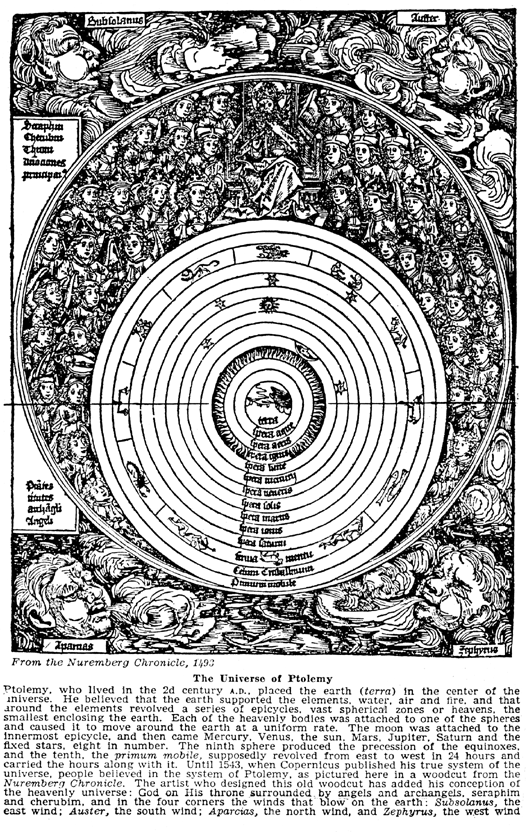
The Ten Emanations of the Tree of Life
...Earthly affairs played the primary
role in determining the fate of the various schools of the Jewish mystics.
By the end of the twelfth century the Cathars had gained control of most of
Provence...And precisely at this time, during the simultaneous mystical revival
of the Jewish community, a number of preeminent Jewish scholars in Southern
France claimed to have received miraculous visits from the prophet Elijah--a
sure sign of the revelation of a profound new mystery.
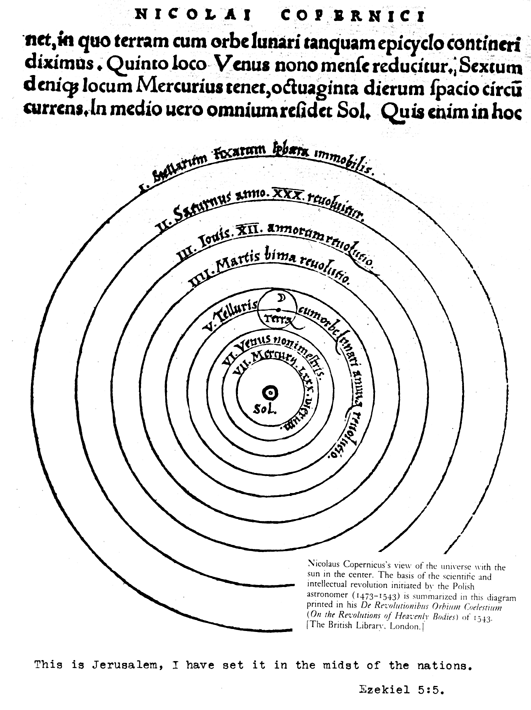
...Indeed, the appearance of the
Bahir was just the beginning of a period of experimentation and speculation
of the nature of God. For depending on the influences that each of the leaders
absorbed, a distinct brand of mysticism emerged. Yet each of the sages to
whom Elijah reportedly appeared seems to have shared a basic and highly heretical
question: If the Supreme God of the universe was beyond all reckoning, shouldn't
the prayers of the faithful be directed to the collective or individual sefirot?
The respected Abraham ben Isaac, chief of the rabbinic court in Narbonne--by
no stretch of the imagination a radical--carefully and circumspectly acknowledged
that there might be a profound truth to this vision of God's emanated powers,
accessible and understandable, in contrast to the Ineffable God...The last
person in medieval Provence who claimed to have been a recipient of a visit
of Elijah was Jacob "the Nazarite"...
(Soon afterwards)...The son of
one of the noted mystics of the previous generation, now emerged as a leader
of a secret esoteric movement that would have enormous influence. He was Isaac
"the Blind," the first medieval kabbalist whose personality and
mystical powers comes through clearly in his surviving writings and in the
frequent references to his words and techniques of meditation...HE VIEWED
THE HEAVENLY WORLD NOT AS A SECRET BUT A SCIENCE. And in the study and teachings
of that science and its practical application in the focused concentration
of prayer, he showed his followers how it might be possible to ascend along
the path of the energy, up to the highest sefirah--of God's limitless and
non-articulated thought.
His commentary on the Book of Creation
was the first to attempt to regularize and describe the Seven lower sefirot
and to understand how their qualities effected the flow of divine energy into
the world. At the heart of his belief--and at the culmination of this first
great transition of Jewish mysticism in Europe from Chariot worship and incantation
to a philosophical discipline--was Isaac's conviction that just as divine
energy flows outward along the trunk and branches of the Tree of Life to every
object, thought, and creature, so it has the potential of flowing back. There
is no necessary dualism between spirit and matter. All has its roots in the
emanations of the Ineffable God, and that rootedness forms a potential connection
by which energy can return to its source. Thus in his technique of meditation,
Isaac taught his students how they might ascend into the worlds of the sefirot
and, in their thought, merge with the highest levels.Yet it was not to be
an escape from the world or a complete merging with God. The object of this
mysticism was the establishment of a powerful, energized connection between
heaven and earth." Heavenly Powers, Unraveling The Secret History
of the Kabbalah, by Neil Asher Silberman, pp.59-70.
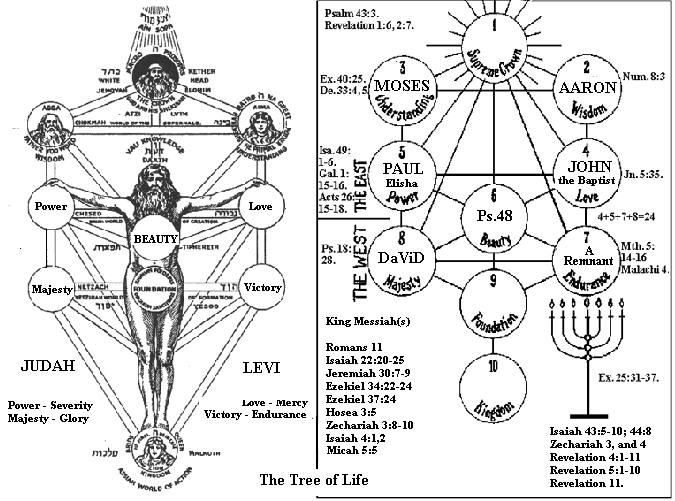
From Seven (the end of one age) to Eight (the beginning of
the next).
As I lay in bed at night
I often ponder depths and heights
Of mountains, sky, and oceans vast.
Of days of now, of times long past.
I wonder about births, and growths, and timely fruits,
Of babies, trees, seeds and roots.
I see the Moon reflect the Sun
And somehow know the two are One.
How high is high, and where is low,
The earth cries out and longs to know.
The Spirit flies to heights above
Where truth unfolds in God's pure Love.
Nancy Elizabeth Guarraci
...As I call upon our Father in that way I pray,
And watch those lonely nights slowly turn into the day.
I'll pray that in your travels God will make you wise,
And turn those paths you're drawn to follow
A ladder in disguise.
N.E.G.
A shell that I have picked up
Where I had sat to pray
Before the Sun, before the Sky, before the Earth and Sea
Is in my pocket with me, I have it still today.
It contains the echoes of my thoughts,
It remembers all my vows.
I reach into my pocket
To have them near me now.
There is no magic in it
No more than is in me,
Or Sun, or Sky, or Earth and Sea,
Or in Eternity.
It is like the staff,
That wooden stick I found.
I took it from the forest
From off the wooded ground.
From a silent place, way on top
A distant lonely hill,
Above the place, one autumn night
Where she is lying still.
It stands a silent witness
In the corner of my room,
To the prayers I prayed that night
In the darkness to the Moon.
To prayers that I have failed to keep,
At least it seems to me.
For I break them in my mind,
Where others cannot see.
But greater yet
Than such despair,
The Sun still shines,
The Moon's still there.
They move with me from place to place,
Through every single frame of mind.
They light the path before me,
Though I stumble far behind.
.............
Another like it now is tied
Around that sacred Tree,
A marriage vow renewed and sealed
Tween earth, myself, and heaven thee....
Tis gravity, elusive power,
Yet nothing but the force of Love,
That weds this world and earth below
To all that is, and worlds above....
I hope (I know) you saw me there,
How could I stay away?
How often, only you can tell,
Since that double fateful day....
It is my place of pilgrimage,
The place on earth that's mine.
It will not be forever though,
But only while it's thine....
The time will come
As all things should,
When all that's left
Is soil and wood.
When your spirit in
the Tree shall be
Then after that
Just memory....
The tree shall fall
And centuries pass,
Yet from this day, a vow renewed
True Love is sealed, and it shall last....
The spell you cast Is working now,
The magic that you made
The medicine you left with me,
The foundation that you laid....
Upon it I shall build a temple
A simple cabin if you will,
Above the Door, a sign that reads
This way to heaven, even still....
I'm on that sturdy ladder now,
The one that makes men whole
The one you built before you left
Right in my heart and soul....
I'll climb it to the upstairs room,
That sacred holy place
The one we built together.
With care and I by grace....
I know that you are waiting there,
As Below, so as Above.
And behind the door, beyond Moon and Sun,
Reconsumate our Love.
As a young man marrieth a virgin, so shall thy sons marry
thee. And as a bridegroom rejoiceth over the bride, so shall thy God rejoice
over thee...(Isaiah 62:1-5).
THE MYSTERY OF SHEKINAH
There is a very true sense in which
the secret doctrines of Israel must be said to center in the Mystery, whatsoever
it may be, which lies behind the wonder and glory of Shekinah...There is furthermore
a very true sense in which it may be said that out of this mystery all Kabbalism
seems to issue and, moreover, goes back therein...
The sole object with which the
Holy One, blessed be (They), sends man into the world is to know that YHVH
is Elohim. Herein is also all true joy of heart. Now it is in this manner
that I open the high conference respecting the Mystery of Shekinah, which
is the mystery of man and God, of man in the likeness of Elohim, of the relationship
of all things above and below, of intercourse, for union upon earth performed
in the spirit of celestial union, and the transmutation of one by the other
is the work of God in the world. In this union abides the Mystery of Faith,
which is the synthesis of the whole Law...
It must be remembered that Elohim
is a title of Shekinah...She is called the Mirror of YHVH. She is now the
Daughter of the King; she is now the Betrothed, the Bride and the Mother,
and again she is sister in relation to the world of man at large. There is
a sense in which the Daughter of God is--or becomes--the Mother of man. In
respect of the manifest universe, she is the architect of worlds, acting in
virtue of the Word uttered by God in creation. In respect of the myth of Paradise,
the Shekinah is the Eden which is above, whence the river of life flows forth
and waters the garden below. And this is also Shekinah as she is conceived
in external things--or Bride, Daughter and Sister in the world below. Considered
in her Divine Womanhood, in the world of transcendence, she is the Beloved
who ascends toward the Heavenly Spouse. And she is Matrona who unites with
the King, for the perfection of the Divine Male is in the Divine Female. Hence
it is said that the perfection of YHVH is in Elohim...She is that Divine Presence
which walked in the Garden of Eden in the cool of the evening, which went
before Israel in the desert and protects the just man who has fulfilled the
precepts, dwelling in his house and going forth with him in his journeys...
Shekinah (the Glory of the Lord)
is female in essential aspect, whether as the Bride of God in that transcendent
state wherein there is no distinction between her and the Holy One, or whether
as the tutelary guide of humanity... It is said elsewhere that those who understand
these male and female relationships know the great wisdom. But the exposition
as to this wisdom is given...when it is stated that Matrona is feminine in
so far as she is not in union , but in that state (where she is sowing the
seed, teaching, instructing), she is identified with the Male principle, and
this is how the interchange of sex in divine things must be understood throughout.
So also Matrona, who is an aspect of (God's Glory) is indifferently male and
female, changing incessantly according to the vibrations of the union. Now
it is said that Shekinah is to Metatron what the Sabbath is to weekdays. In
other words she is Rest and the rapture of Rest, yet it is that rest in which
there is the intercourse of spiritual union...
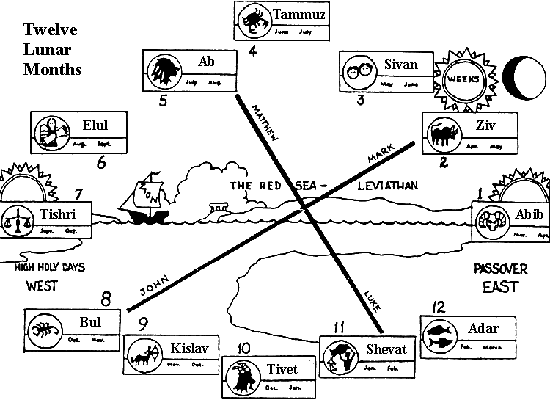
There are two points which should
be memorized on this subject. At the apex of the union between male and female--which
is to be understood only in the spiritual sense--the sex differentiation has
ceased: it can only be from this point of view that the Shekinah is mentioned
sometimes as if she were on the male side. This is the first point, and the
second is that in characteristics and in mission, she is always typically
female; it is she who comprises all women in her mystery, and this is why,
as we shall see, she does not abide except with him who is united to a woman
(Male with female, female with male).
THE MYSTERY OF SEX
(The Tantric Reasonings
of Kabbalah).
There is one definition which is
in keeping with the tradition at large, and this is that marriage is the union
of the Sacred Name here below--that is, its completion in every person. The
thesis is that circumcision (the spiritual circumcision of the heart,
to which all must attain) is the
symbol of all purity in sexual intercourse...
This sacred sign of the Covenant
constitutes the root-matter of the Sacred Name and of the Mystery of Faith.
As the Sun enlightens the world, so the sacred sign (circumcision)
enlightens the body. (It reveals the nature and the power of the Flesh...Galatians
5)...But as the advantage is greater
with which the children of Israel begin their earthly life, so is the responsibility
greater if they make the Covenant of no effect in their own person.
Now the Sacred Name is never attached
to an incomplete (person), being one who is unmarried (male with female,
female with male), or one who dies
without issue.(Remember, we must divide the Word correctly. We are
discussing spiritual principles, not literal restrictions. Paul himself was
both unmarried and without issue in the purely literal and physical sense;
but greatly married and with many children in the spiritual sense).
Such a person does not penetrate after death into the vestibule of Paradise,
on account of their incompleteness. They must be planted anew--that is to
say, they must suffer rebirth, as we have seen, in order that the Sacred Name
my be complete in all directions...
God blessed Adam because they were
made male and female, and blessings are found only where male and female are
united for the purpose of creation which--according to the counsel of Elohim--was
to increase, multiply and replenish the earth.
And we have next to see after what
manner those who exalted so highly the nuptial state gave instruction on its
practice here below. The doctrine was that no marriage is made on earth before
it is proclaimed in heaven (Understand Joel 2:16),
and that the Holy One accomplishes unions in the world above before the descent
of souls on earth...The fulfillment of the marriage is in the raising of the
heart and mind on the part of the lover and beloved, to the Most Holy Shekinah,
the glory which cohabits and indwells during the external act...so that the
two spirits are melted together and are interchanged constantly between body
and body...In the indistinguishable state which arises it may be said that
the male is with the female neither male nor female: at least they are both
or either. So is man affirmed and composed of the world above, which is male,
and of the female world below. The same is true of both.
According to the Zohar those words
in the Song of Solomon" "Thy breasts are better than wine"
refer to that wine which provokes joy and desire; and seeing that all things
are formed above according to a pattern which is reproduced faithfully below,
it is held to follow that when desire awakens beneath it awaken also on high.
Herein lies the sanctity of espousals on earth and herefrom depends the need
for exalting that sanctity and all that belongs to espousals in the highest
grade.
The Children of the Doctrine are
described (in the Zohar) as reserving conjugal relations for the night of
the Sabbath, being the moment when the Holy One is united to the Community
of Israel. The thesis is that God is One and as such it is agreeable to Him
to be particularly concerned with a people who are One. Out of this arises
the question as to when "man" may be called One, and the answer
is that this comes about when the male is united to the female in a holy purpose:
it is then that man is complete, is one, and is without blemish. It is of
this that the two must think at the moment of their union; it is in uniting
bodies and souls that the two become One. Man in particular is termed one
and perfect; they draw down the Holy Spirit upon them and are called the Son
of the Holy One, blessed be (They).
According to Rabbi Simeon, the
relations of the patriarchs with their wives were actuated by a Supreme Mystery.
So long as Jacob was unmarried, God did not manifest to him clearly, and this
mystery is familiar to those who are acquainted with the ways of the Law.
After marriage he arrived at the perfection which is above, as distinguished
from the perfection which is below, and God manifested to him clearly. The
explanation that the Supreme Wisdom is one with the Mystery of Sex is intimated
in the Law itself...
It is not to be supposed, the union
of humanity below--being in its consecration a reflection of the Divine Union--that
there should not be a union of souls in the world to come, that in the beauty
of the true region of Life they should not continue to reflect the Supernal
Mystery... What is understood is the union in heaven of souls who have been
espoused on earth--being those who were espoused previously before the world
began. When it is said that the Blessed Vision is the sight of the Shekinah
and the contemplation of Her Divine Face, we are to understand that the union
of all sister-souls is under her eyes and in her presence. It is said that
in the heights of heaven there is yet another union of two born of love and
for ever inseparable. The Holy Kabbalah.
.
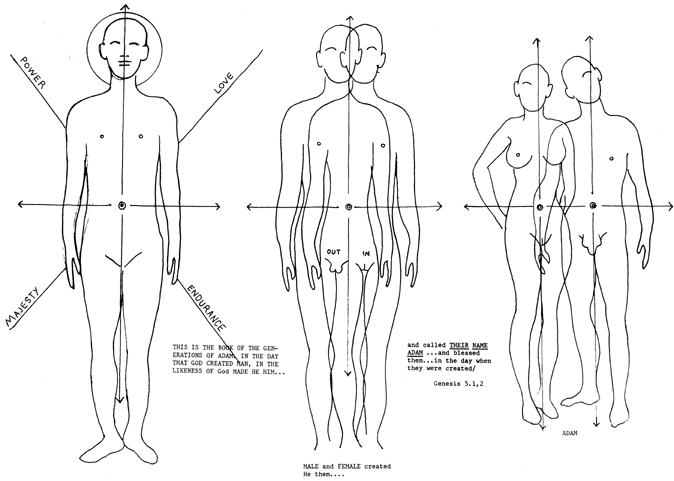

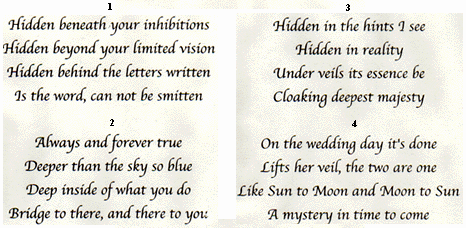
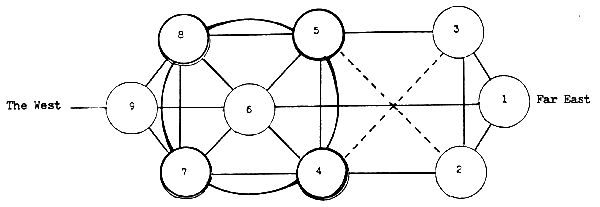
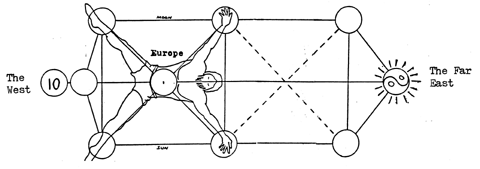


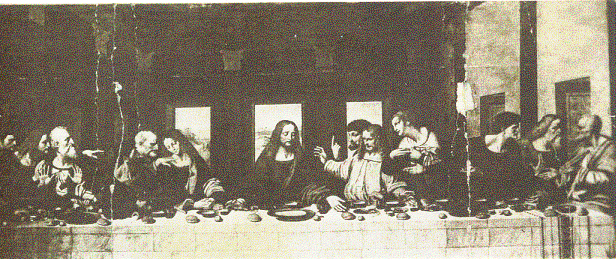
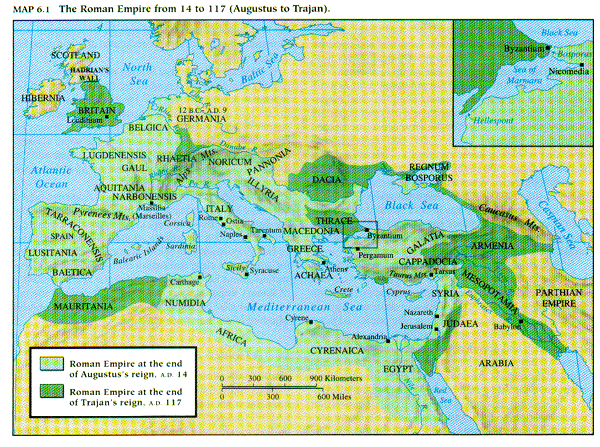
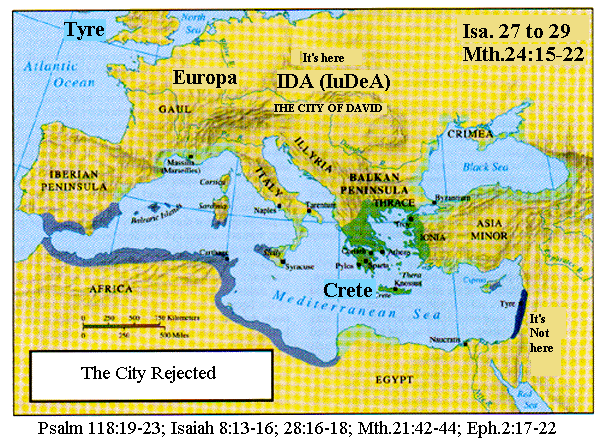
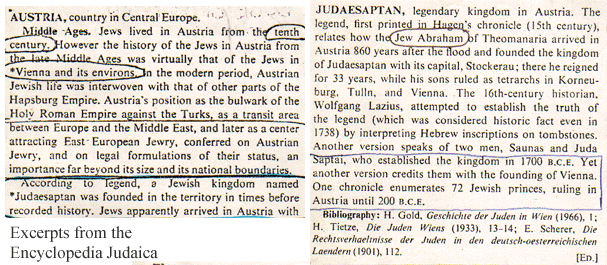
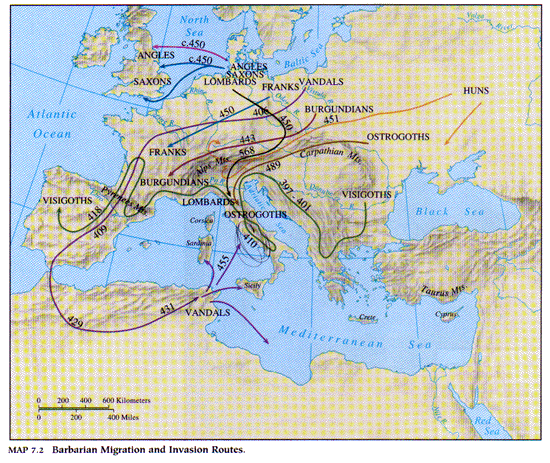

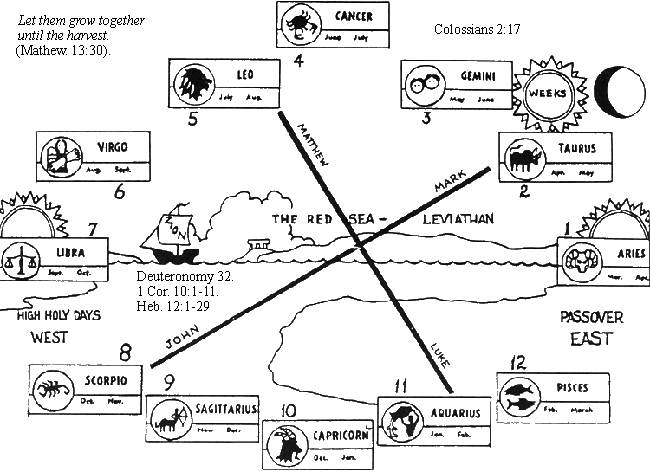
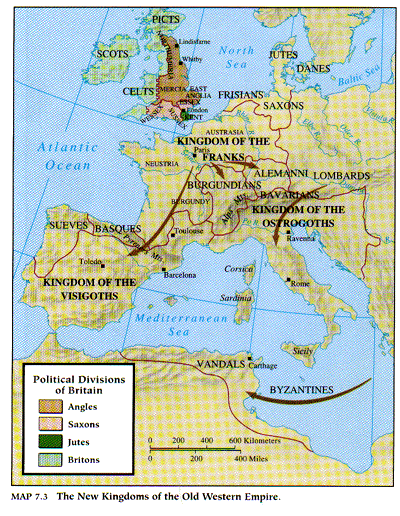

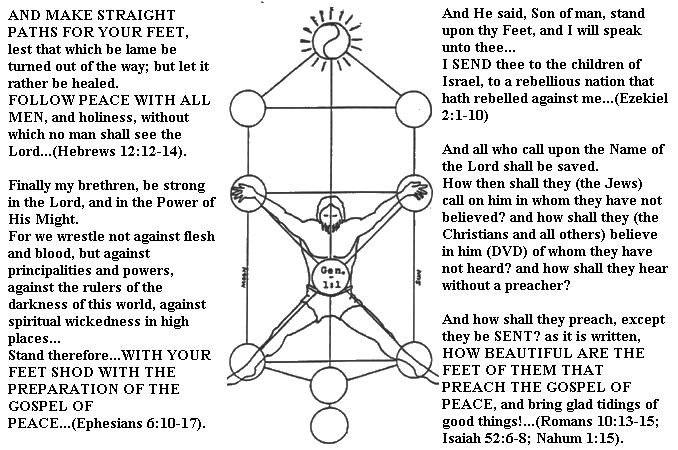
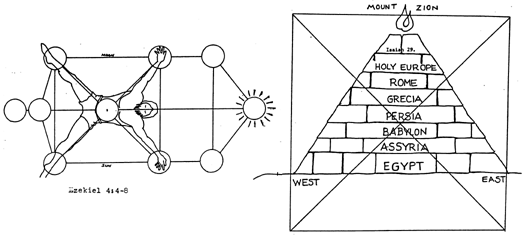
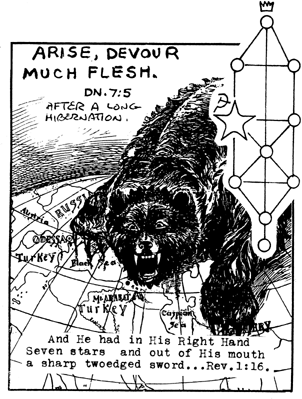
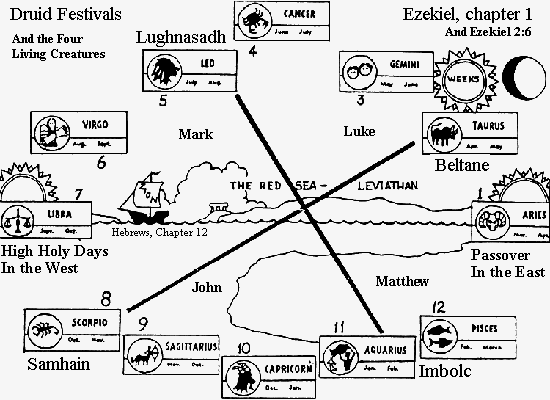 .
.
